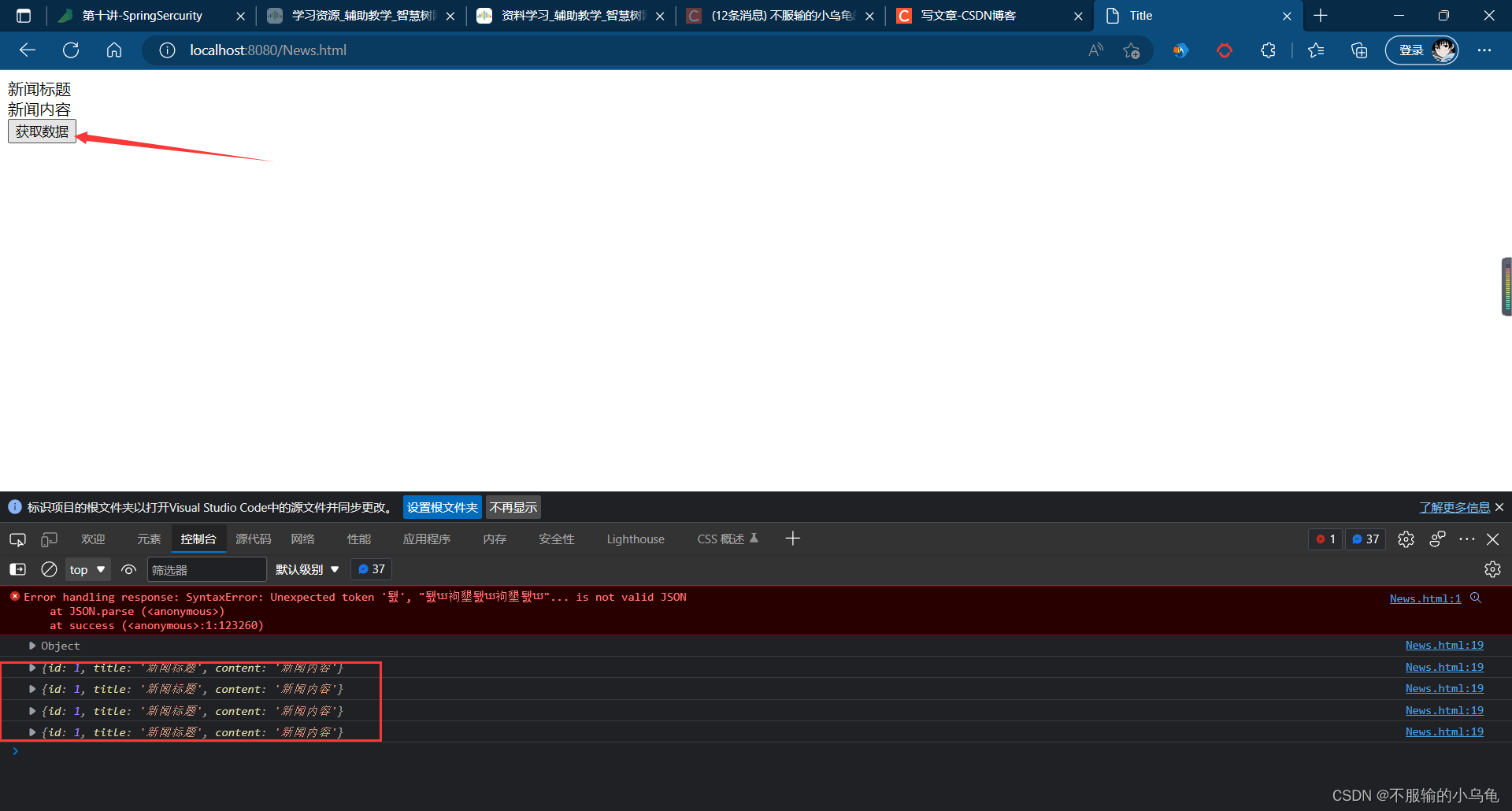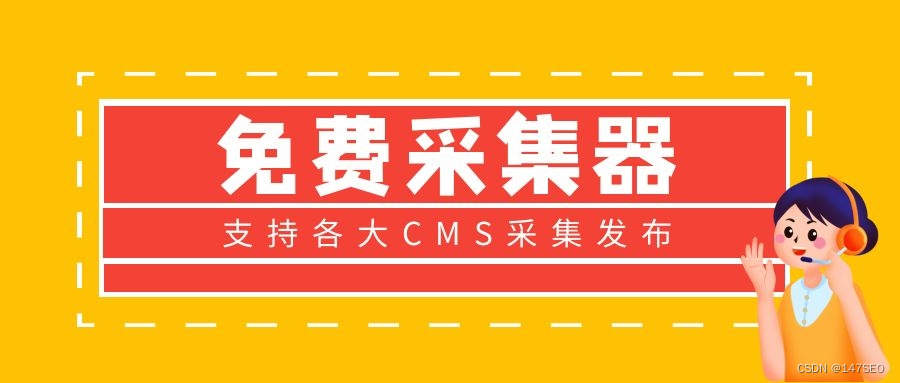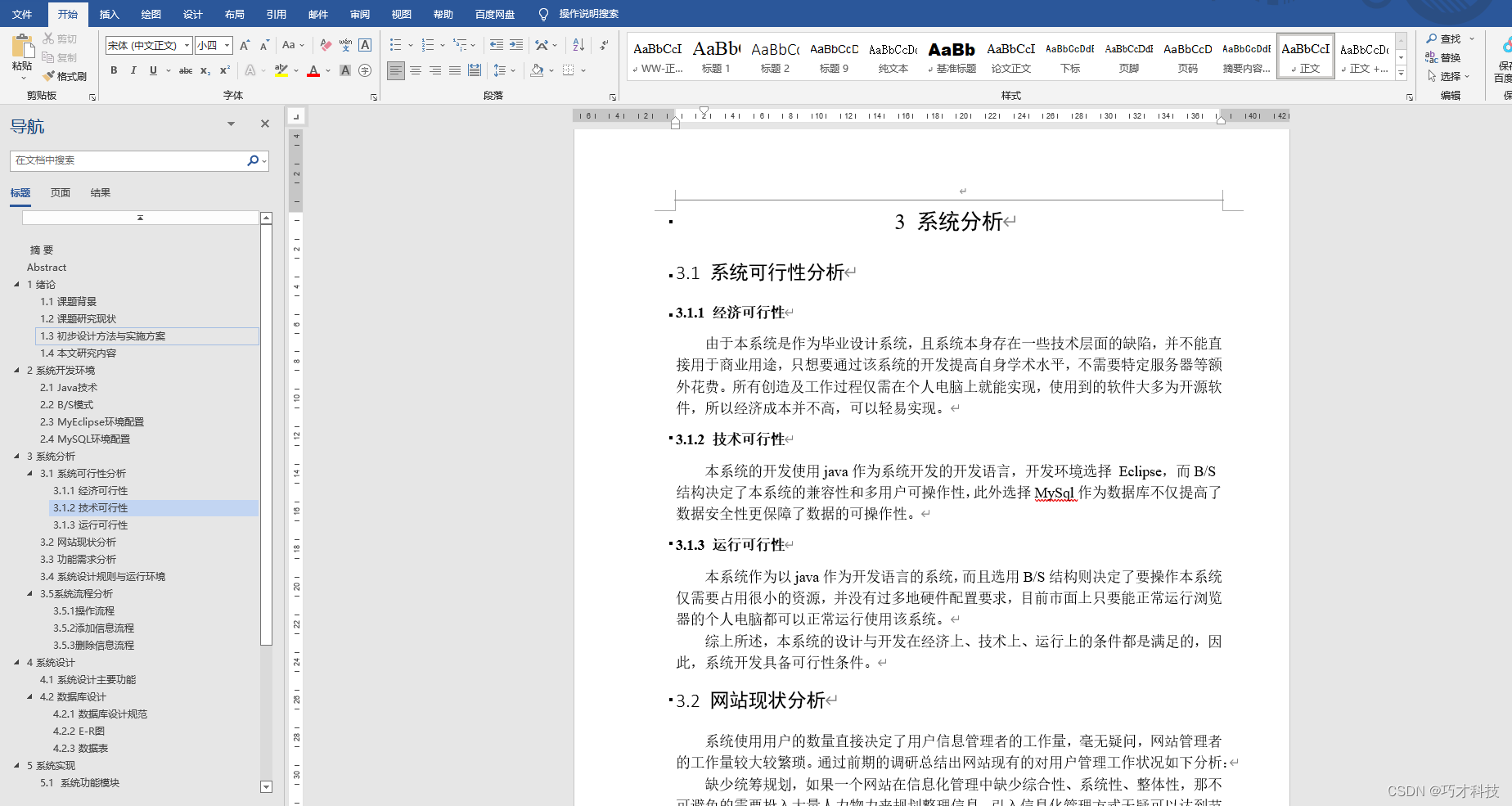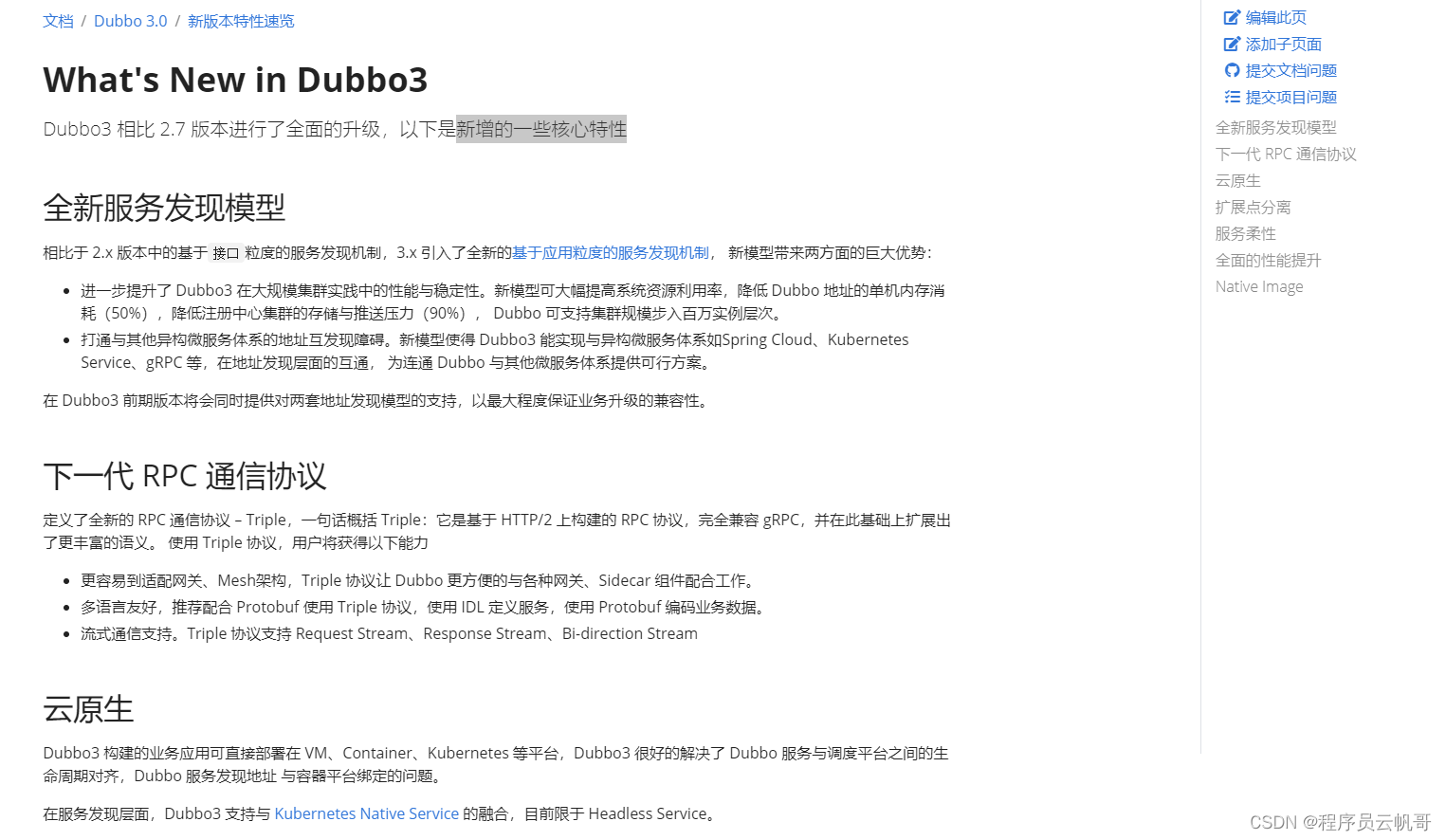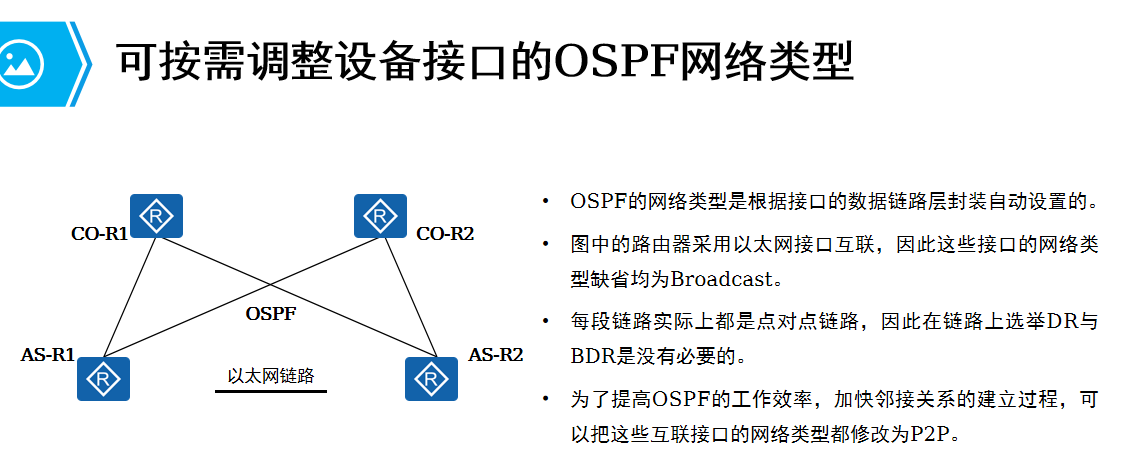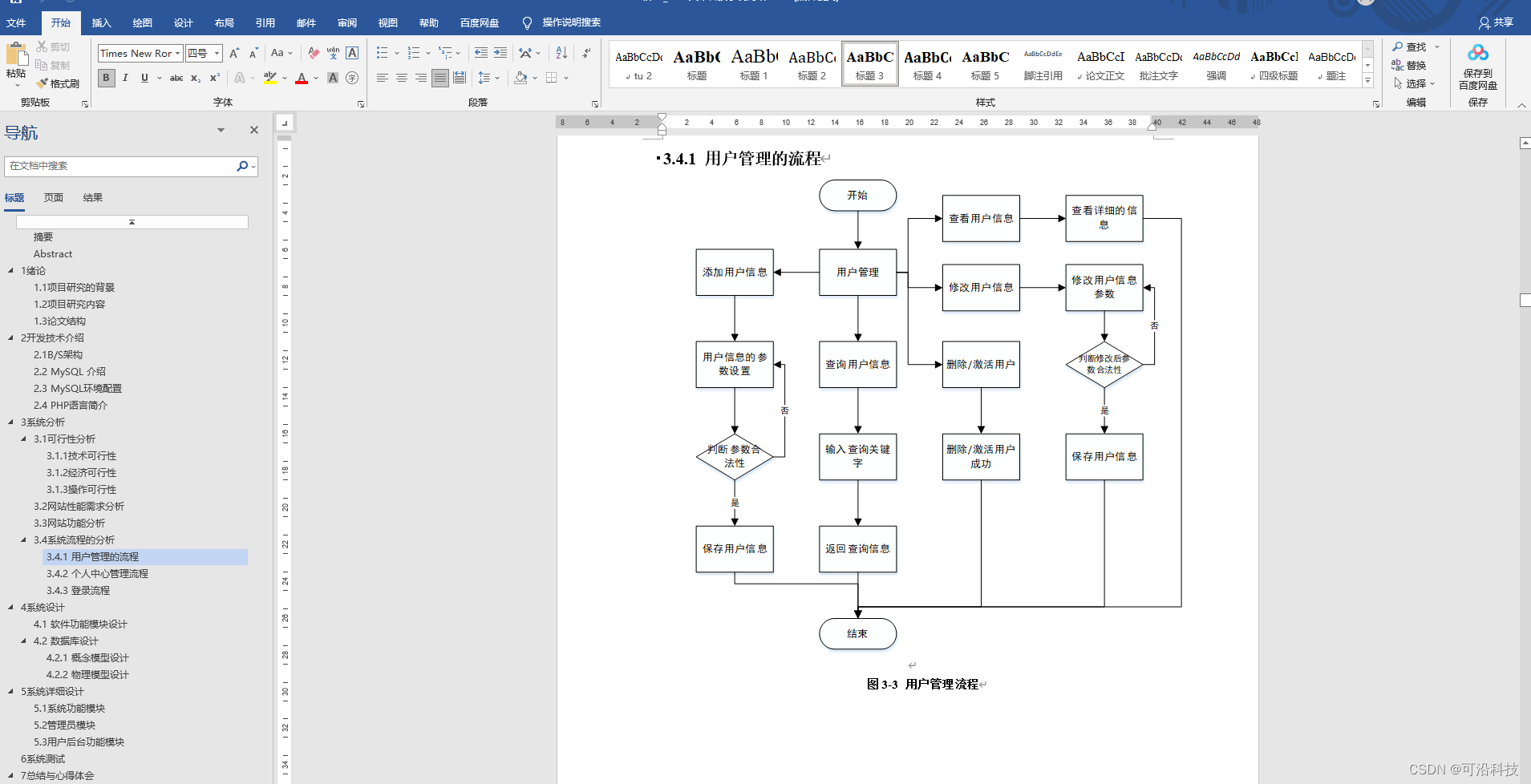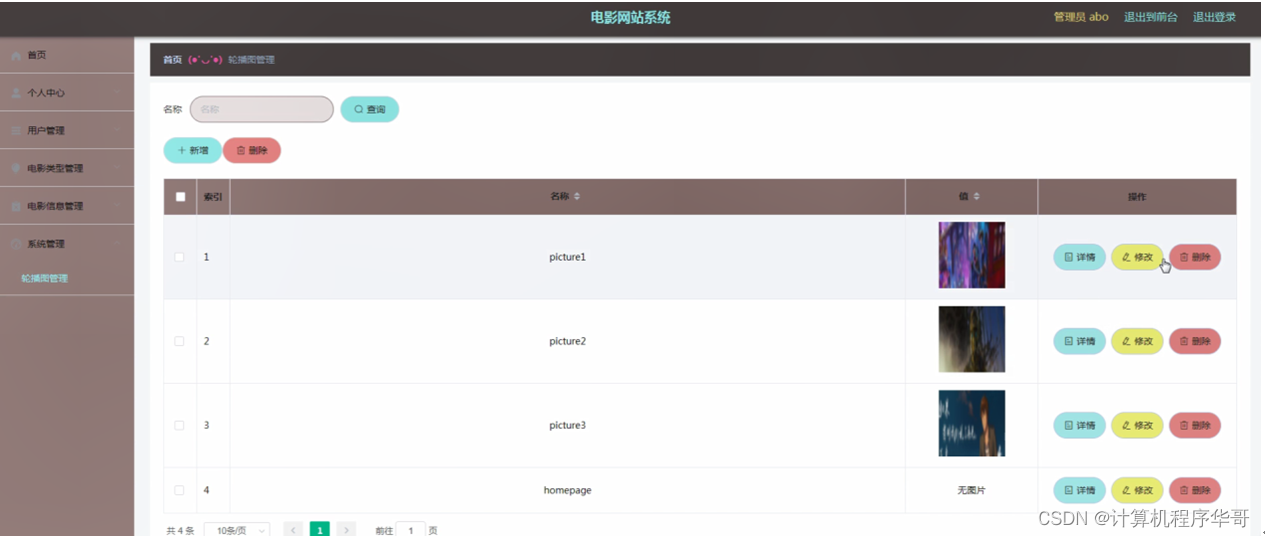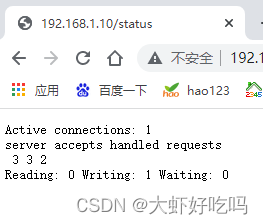Spring Boot开发之SpringSercurity
- 一、授权
- 1、打开上次项目以及数据库
- 2、有的页面不登录也能访问,比如首页、登录以及注册等,因此对于某些请求不需要登录则放行这些接口
- (1)修改MySercurityConfig
- (2)修改TestController类
- (3)点击运行,在没登录时访问/home、/login路径不需要登录,而其他界面都被拦截并跳转到登录页面
- 3、修改MySercurityConfig类,多增加一个admin用户,user用户拥有user权限,admin用户拥有admin、user权限
- 4、在templates文件夹下新建user.html和admin.html
- 5、修改TestController类
- 6、点击运行,登录user用户可以访问user页面,但不可以访问admin页面;登录admin用户既可以访问user页面,也可以访问admin页面
- (1)登录user用户
- (2)登录admin用户
- 二、数据库认证:从数据库中获取用户名和密码进行验证
- 1、在utils文件夹下新建MyUserService类
- 2、修改MySercurityConfig类
- 3、点击运行,登录user用户可以访问user页面,但不可以访问admin页面;登录admin用户既可以访问user页面,也可以访问admin页面
- (1)登录user用户
- (2)登录admin用户
- 三、自定义登录页面
- 1、修改MySercurityConfig类
- 2、修改login.html
- 3、点击运行,登录页面变成我们自定义的页面啦
- 四、自定义登出页面
- 1、修改MySercurityConfig类
- 2、在templates文件夹下新建mylogout.html
- 3、修改TestController类
- 4、点击运行,登出页面也变为我们自定义的页面啦,退出登录后回到登录页面
- 五、文件上传
- 1、修改application.properties
- 2、在templates文件夹下新建file.html
- 3、在controller文件夹下新建FileController类
- 4、点击运行,选择文件成功
- 5、修改MySercurityConfig类,设置"/**"放行所有接口
- 6、修改FileController类
- 7、点击运行,选择文件成功提交到指定路径
- 8、修改FileController类,为了防止因文件名字相同而出现文件覆盖问题,将文件名设置为随机数+文件名
- 9、点击运行,提交两次相同文件,文件不会被覆盖
- 10、修改FileController类,将文件显示出来
- 11、修改success.html
- 12、点击运行,显示图片成功
- 六、请求JSON接口
- 1、在pojo文件夹下新建News类
- 2、在controller文件夹下新建JSONController类
- 3、修改MySercurityConfig类
- 4、在templates文件夹下新建News.html
- 5、点击运行,成功获取JSON数据
今天接着学习SpringSercurity的相关知识以及实现,都非常基础。首先打开上次项目以及数据库,上次我们学习到了认证,今天接着学习。
一、授权
1、打开上次项目以及数据库
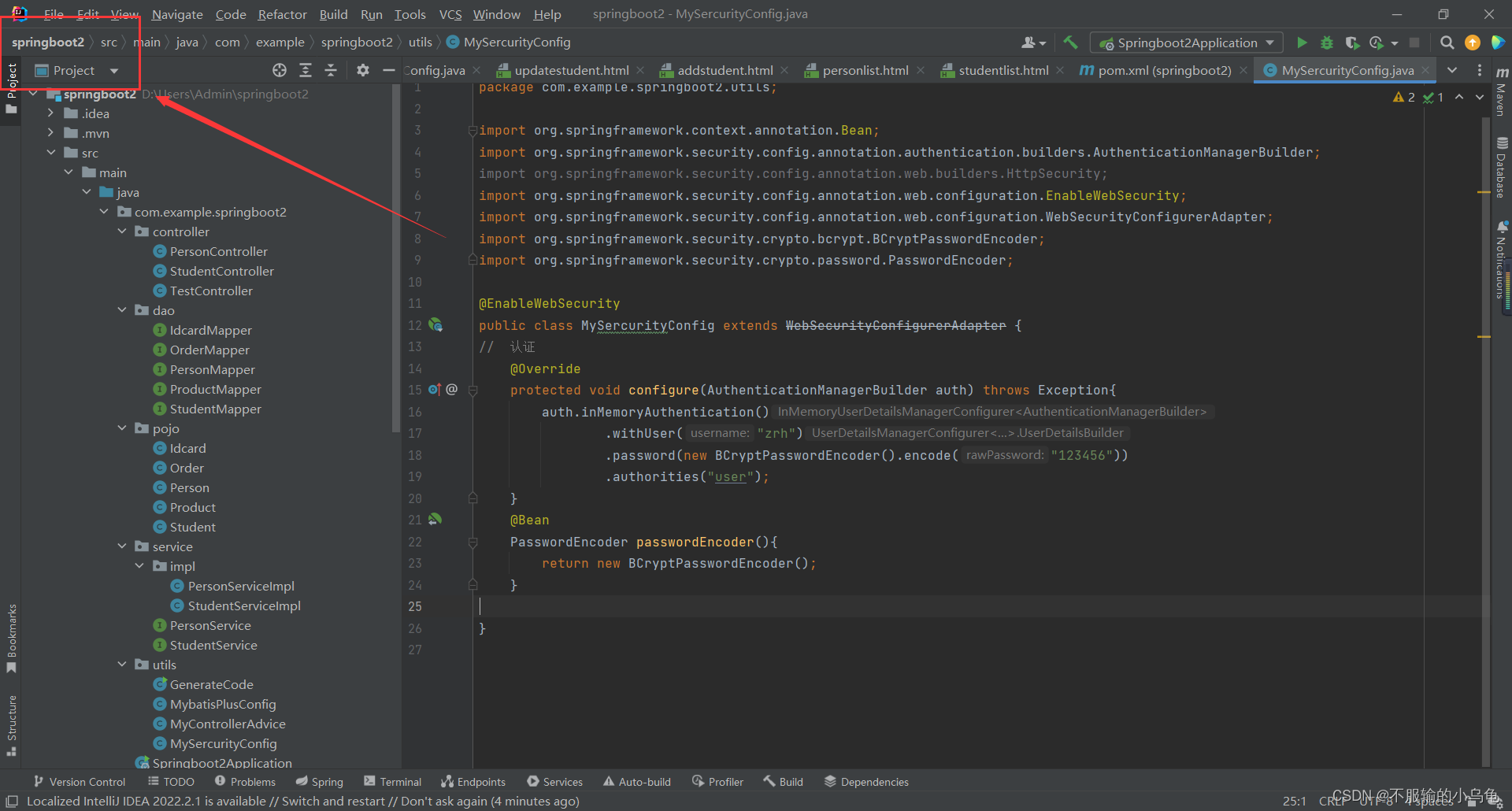
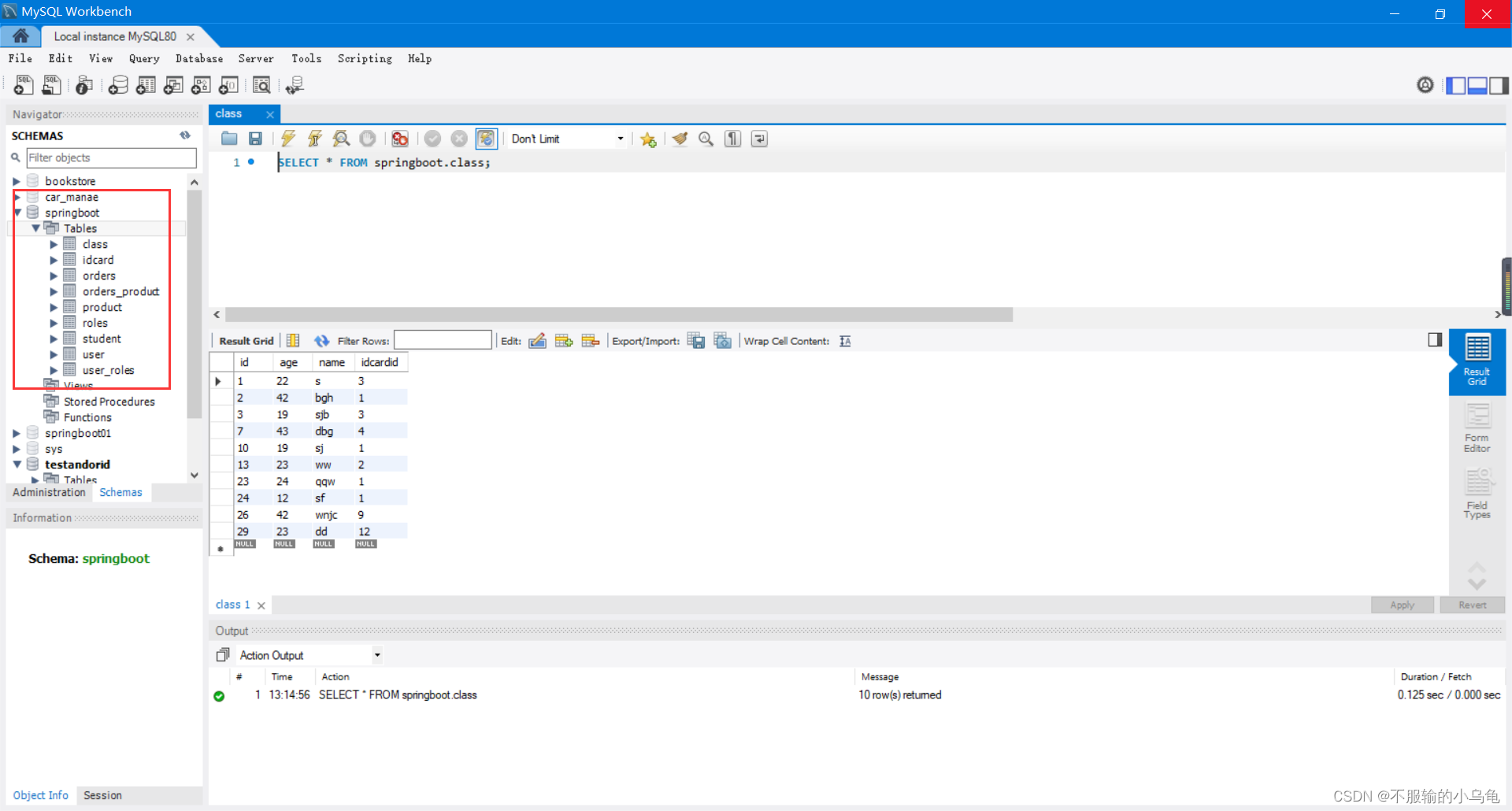
2、有的页面不登录也能访问,比如首页、登录以及注册等,因此对于某些请求不需要登录则放行这些接口
(1)修改MySercurityConfig
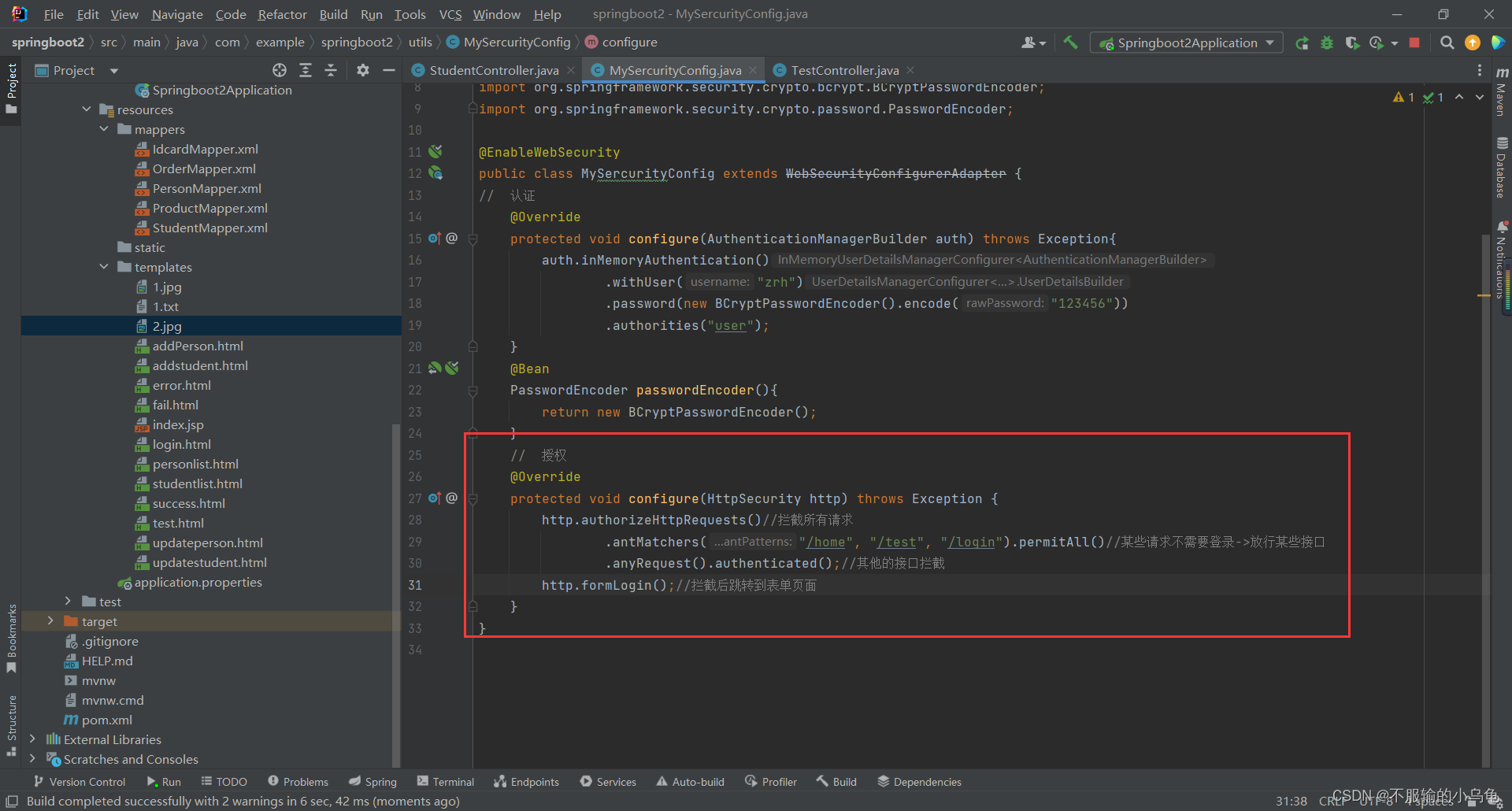
// 授权
@Override
protected void configure(HttpSecurity http) throws Exception {
http.authorizeHttpRequests()//拦截所有请求
.antMatchers("/home", "/test", "/login").permitAll()//某些请求不需要登录->放行某些接口
.anyRequest().authenticated();//其他的接口拦截
http.formLogin();//拦截后跳转到表单页面
}
(2)修改TestController类
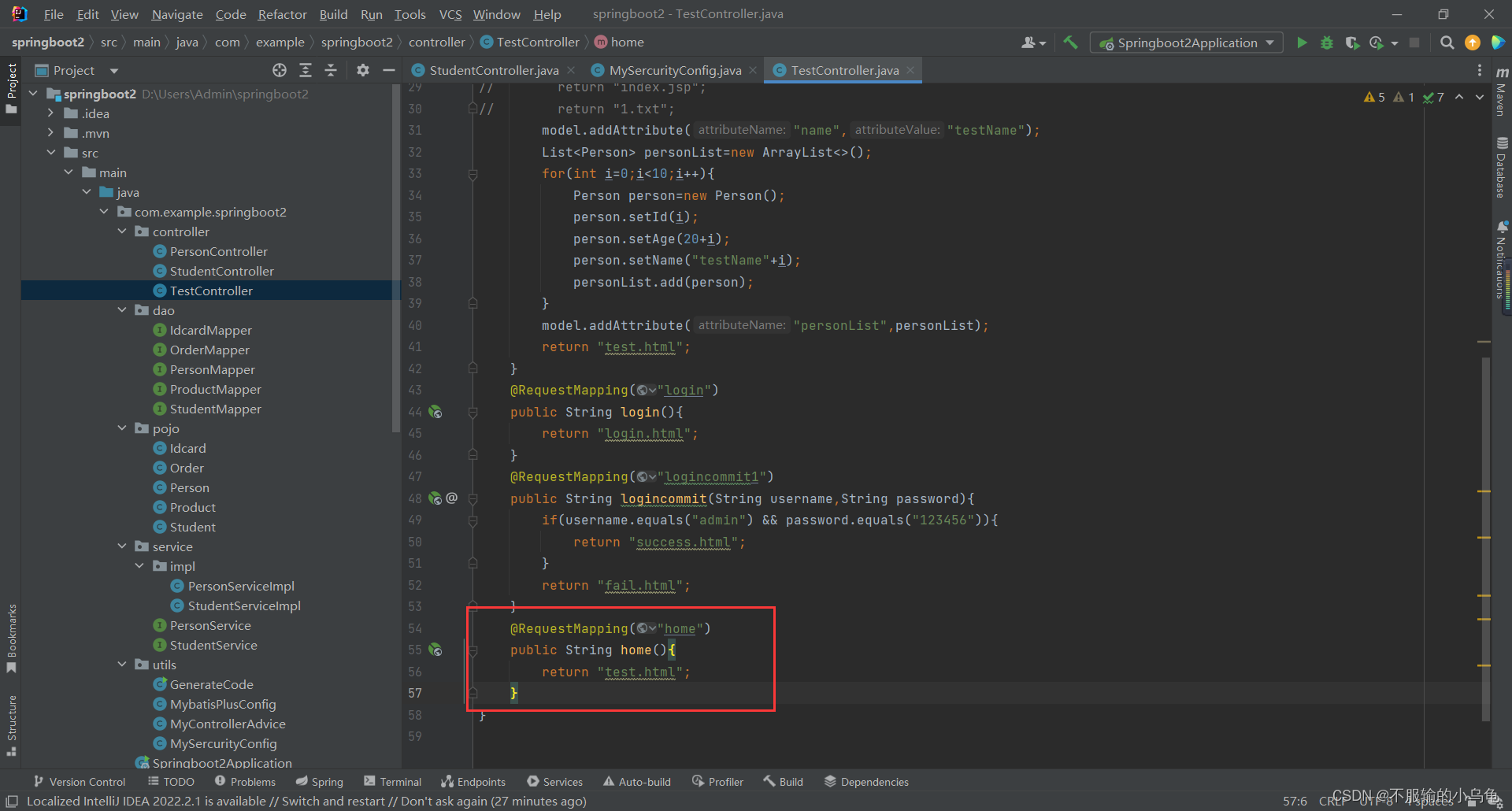
@RequestMapping("home")
public String home(){
return "test.html";
}
(3)点击运行,在没登录时访问/home、/login路径不需要登录,而其他界面都被拦截并跳转到登录页面
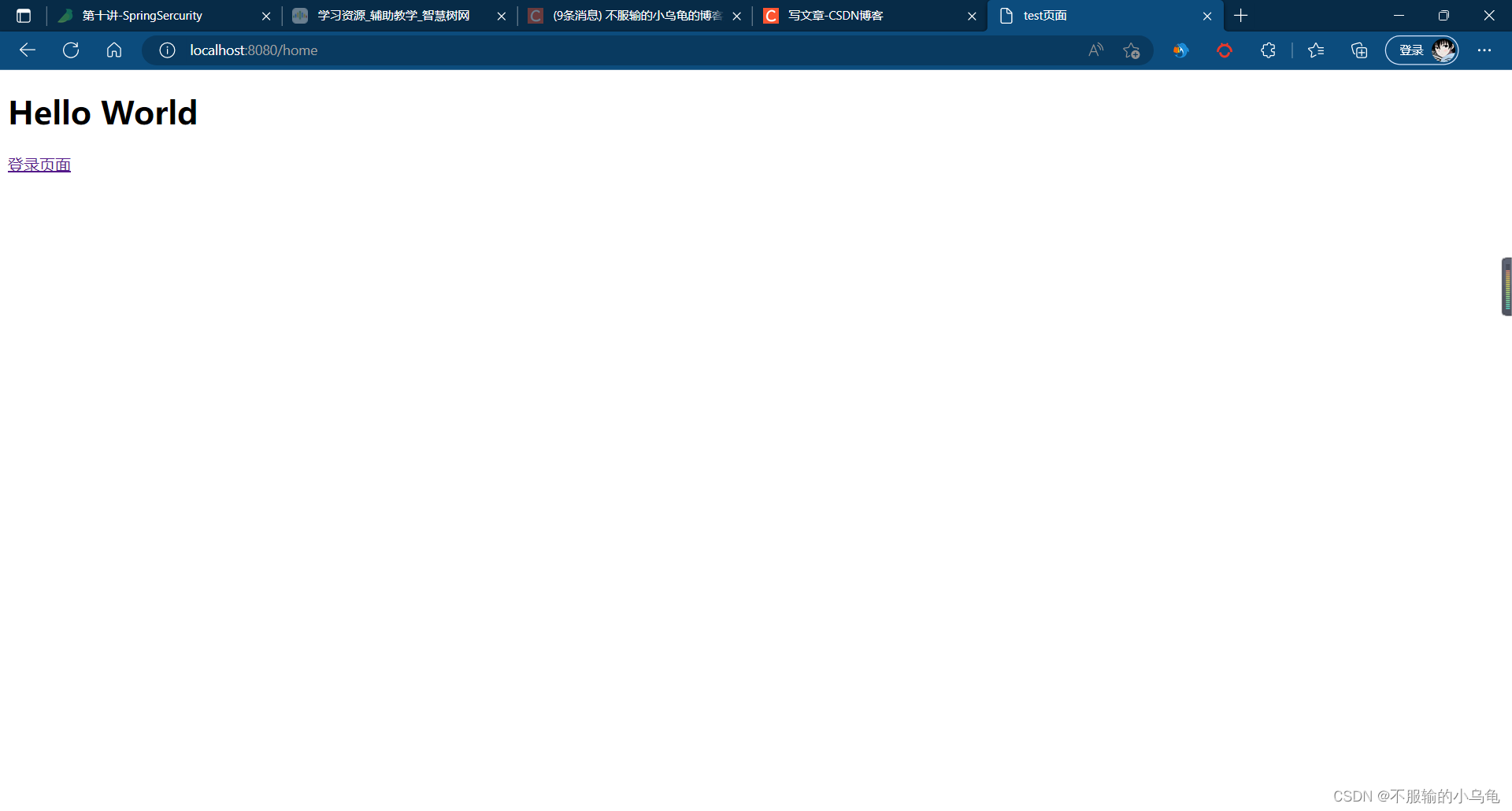

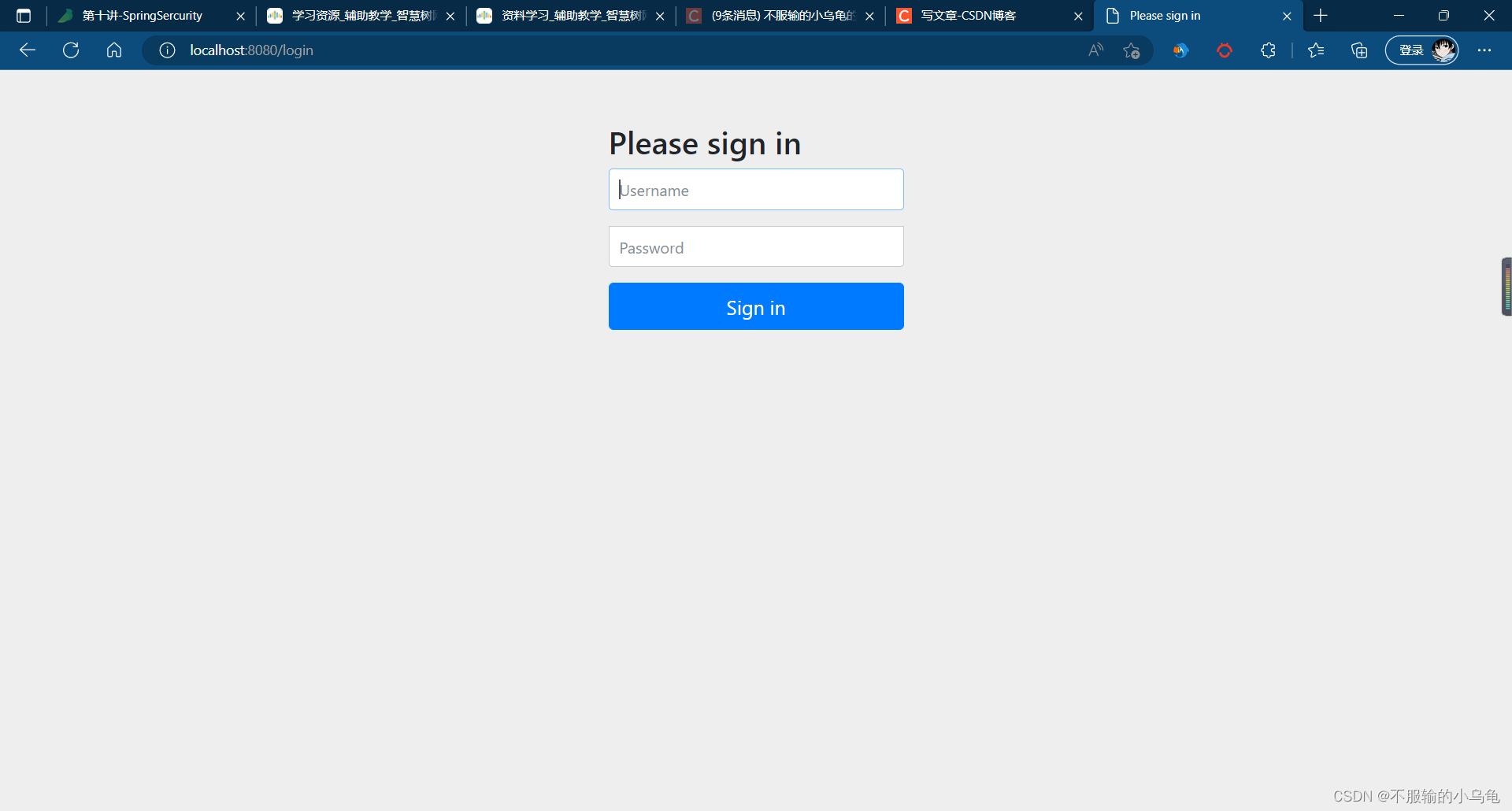
3、修改MySercurityConfig类,多增加一个admin用户,user用户拥有user权限,admin用户拥有admin、user权限
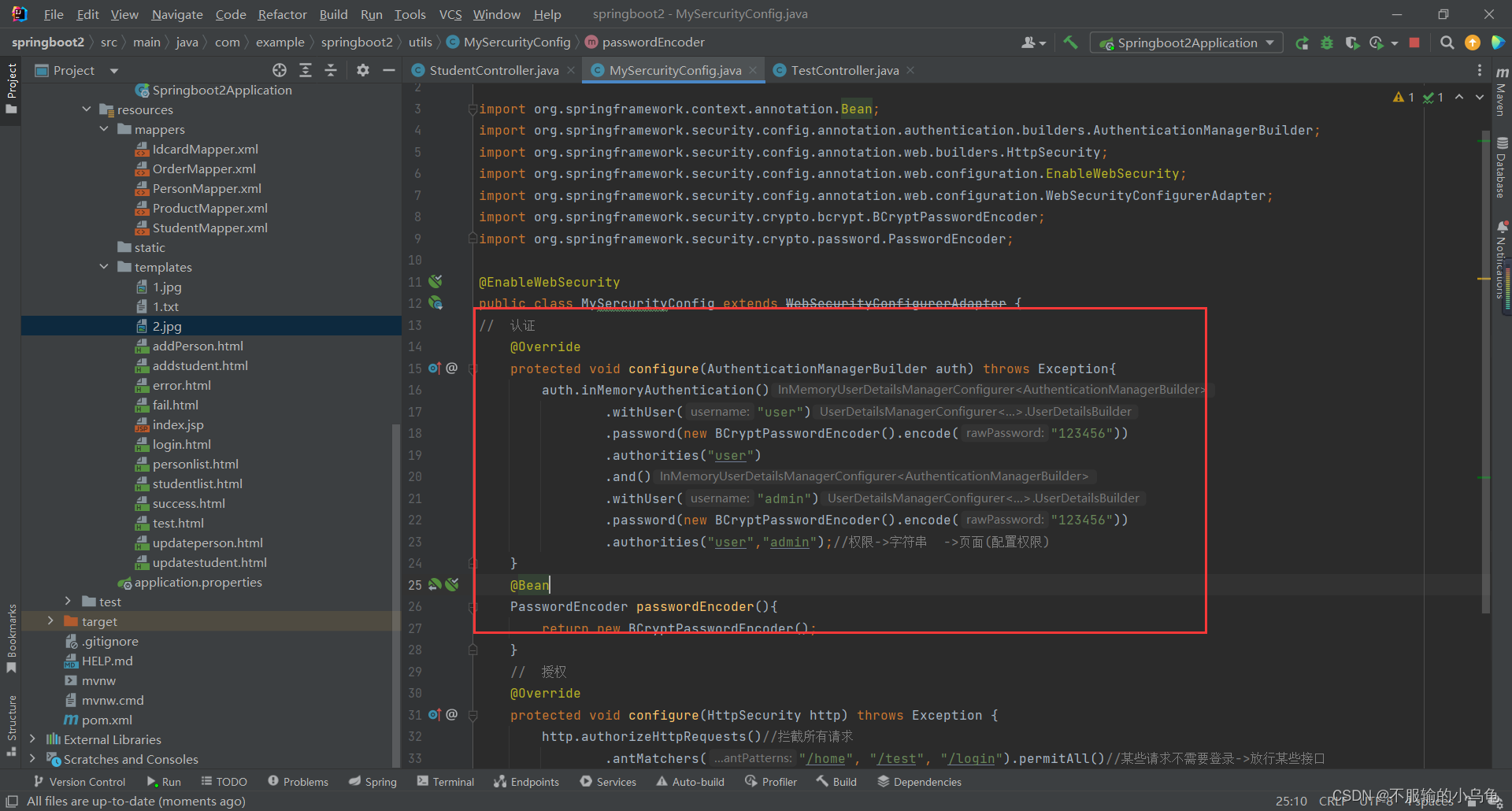
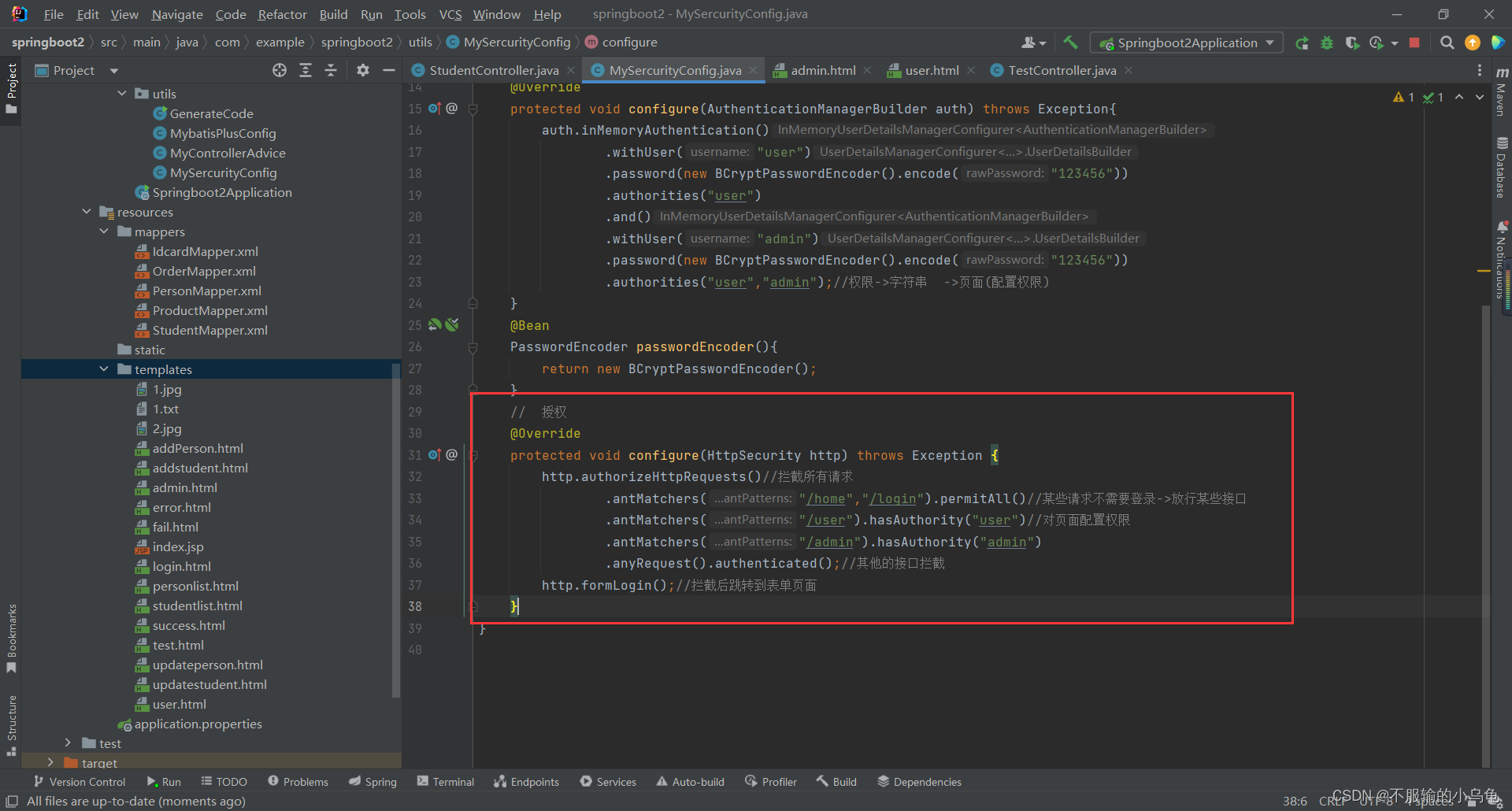
// 认证
@Override
protected void configure(AuthenticationManagerBuilder auth) throws Exception{
auth.inMemoryAuthentication()
.withUser("user")
.password(new BCryptPasswordEncoder().encode("123456"))
.authorities("user")
.and()
.withUser("admin")
.password(new BCryptPasswordEncoder().encode("123456"))
.authorities("user","admin");//权限->字符串 ->页面(配置权限)
}
// 授权
@Override
protected void configure(HttpSecurity http) throws Exception {
http.authorizeHttpRequests()//拦截所有请求
.antMatchers("/home","/login").permitAll()//某些请求不需要登录->放行某些接口
.antMatchers("/user").hasAuthority("user")//对页面配置权限
.antMatchers("/admin").hasAuthority("admin")
.anyRequest().authenticated();//其他的接口拦截
http.formLogin();//拦截后跳转到表单页面
}
4、在templates文件夹下新建user.html和admin.html
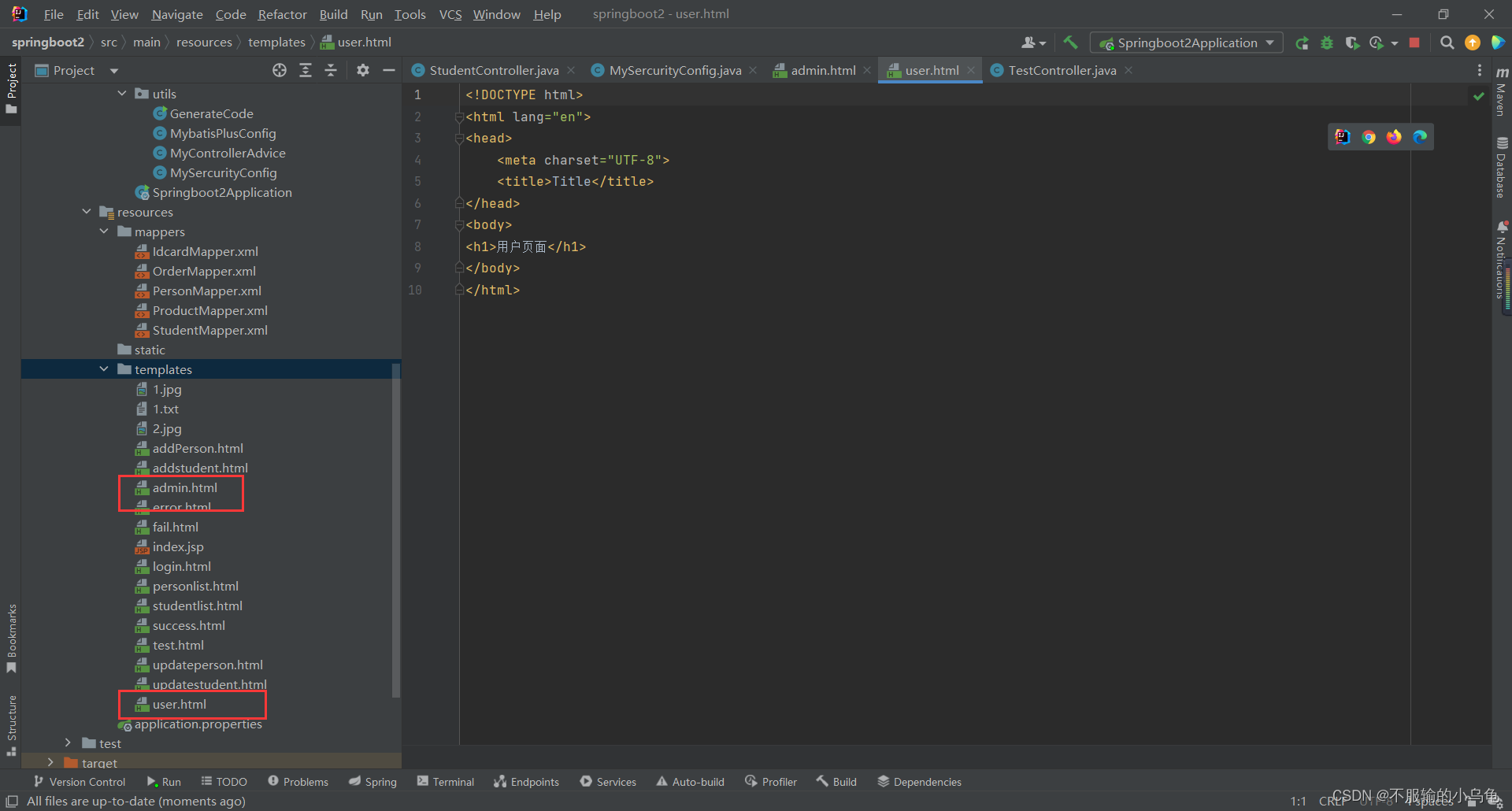
<!DOCTYPE html>
<html lang="en">
<head>
<meta charset="UTF-8">
<title>Title</title>
</head>
<body>
<h1>用户页面</h1>
</body>
</html>
<!DOCTYPE html>
<html lang="en">
<head>
<meta charset="UTF-8">
<title>Title</title>
</head>
<body>
<h1>admin页面</h1>
</body>
</html>
5、修改TestController类
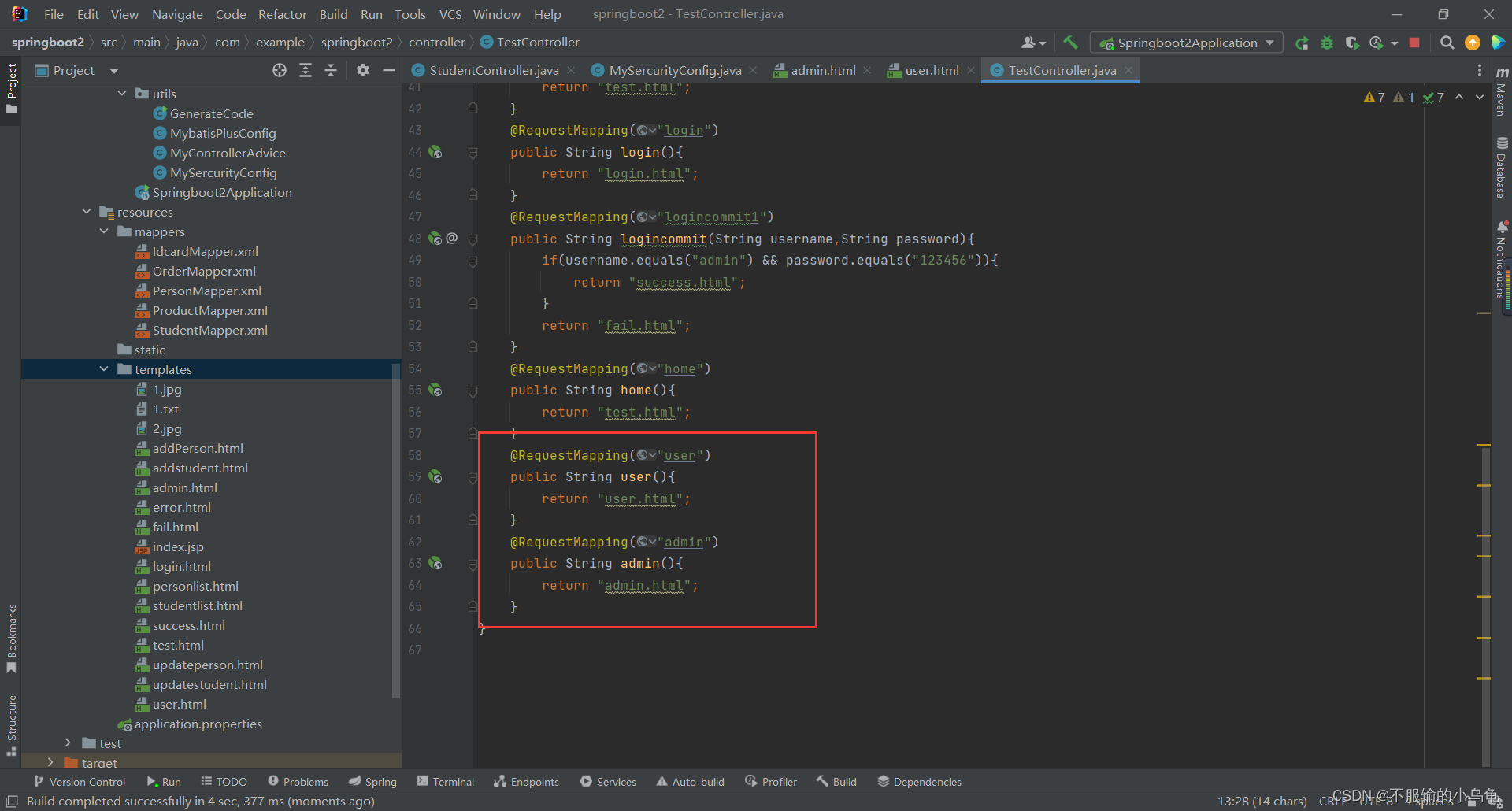
@RequestMapping("user")
public String user(){
return "user.html";
}
@RequestMapping("admin")
public String admin(){
return "admin.html";
}
6、点击运行,登录user用户可以访问user页面,但不可以访问admin页面;登录admin用户既可以访问user页面,也可以访问admin页面
(1)登录user用户
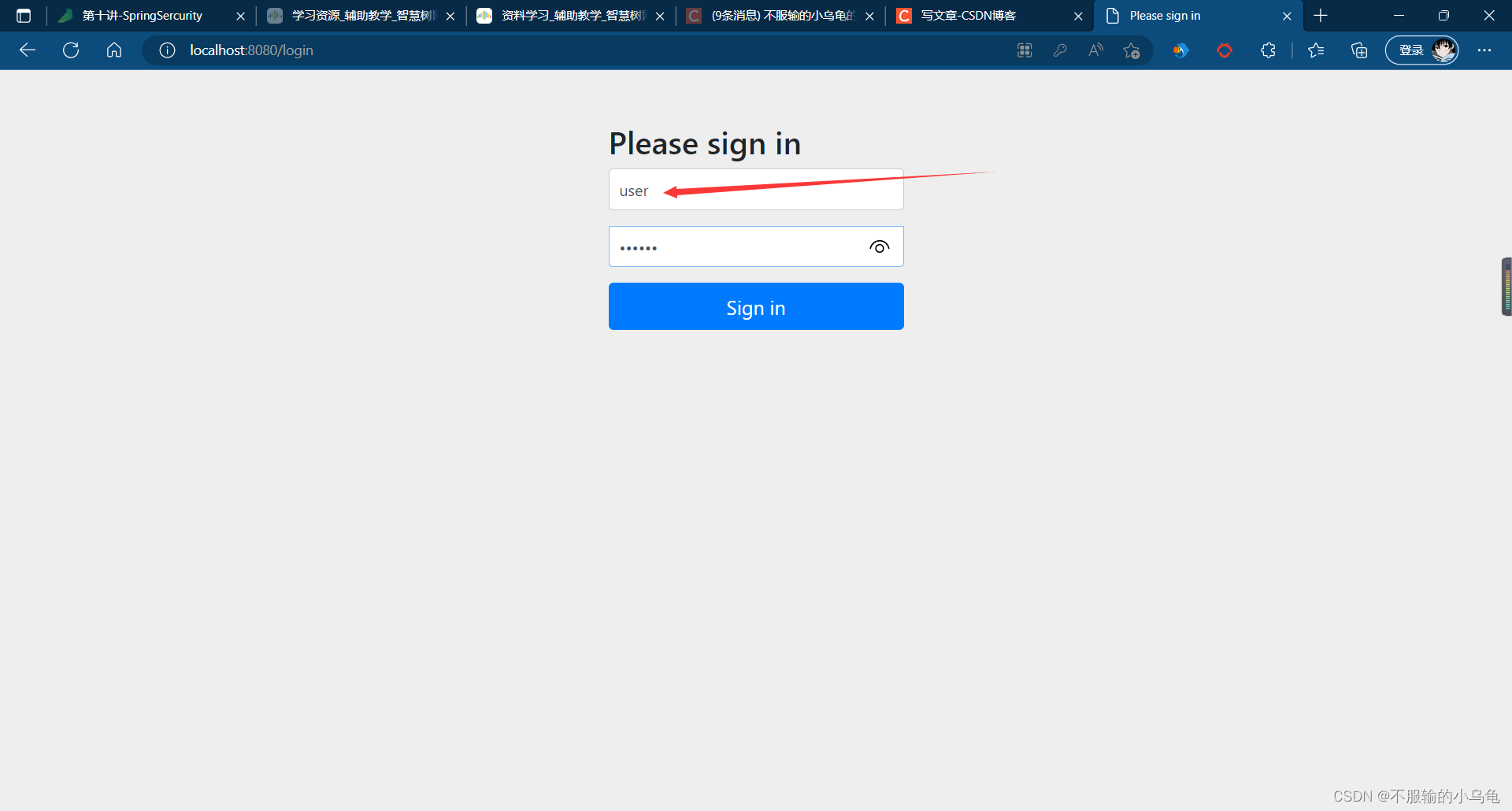
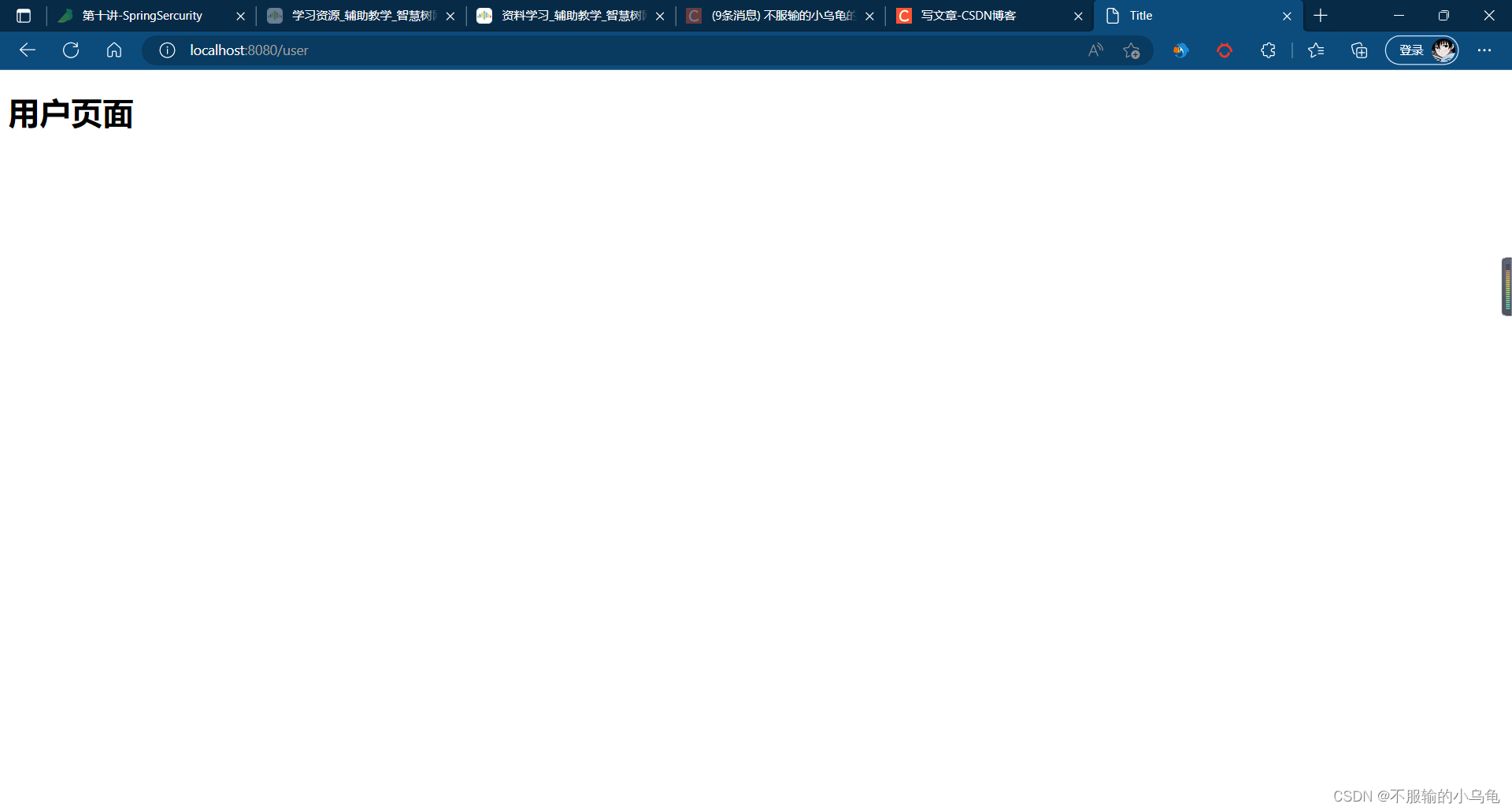
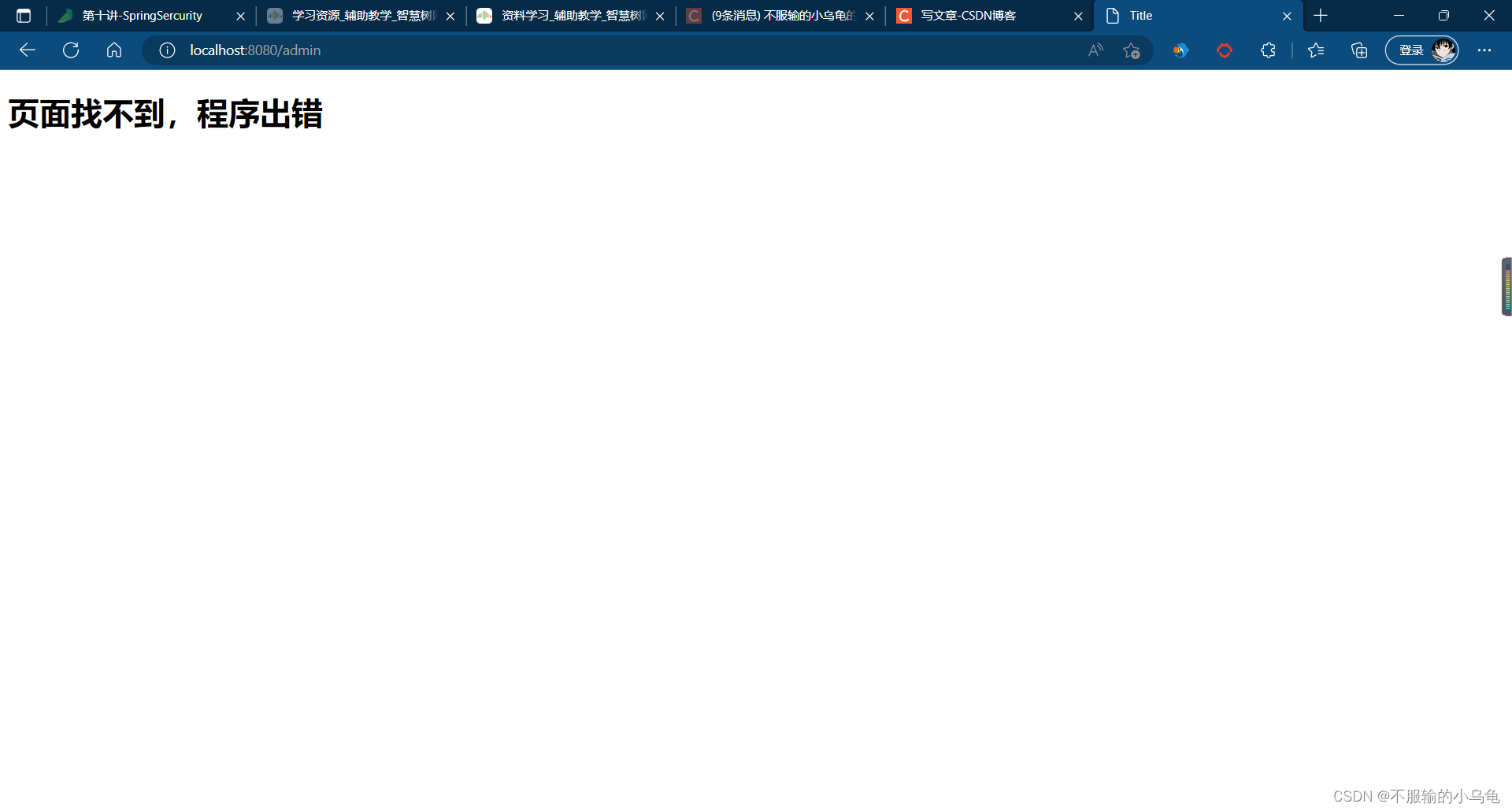
(2)登录admin用户
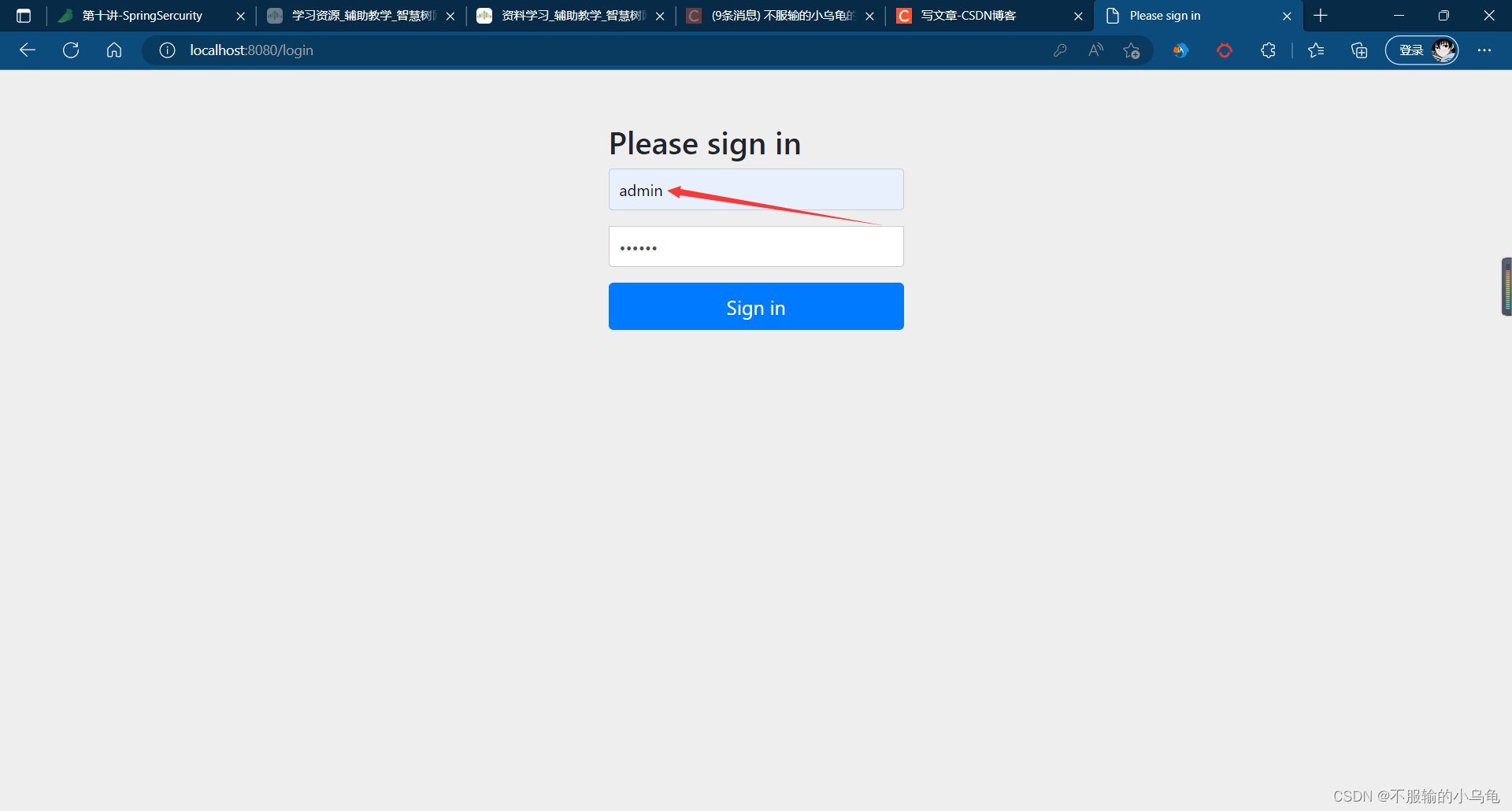
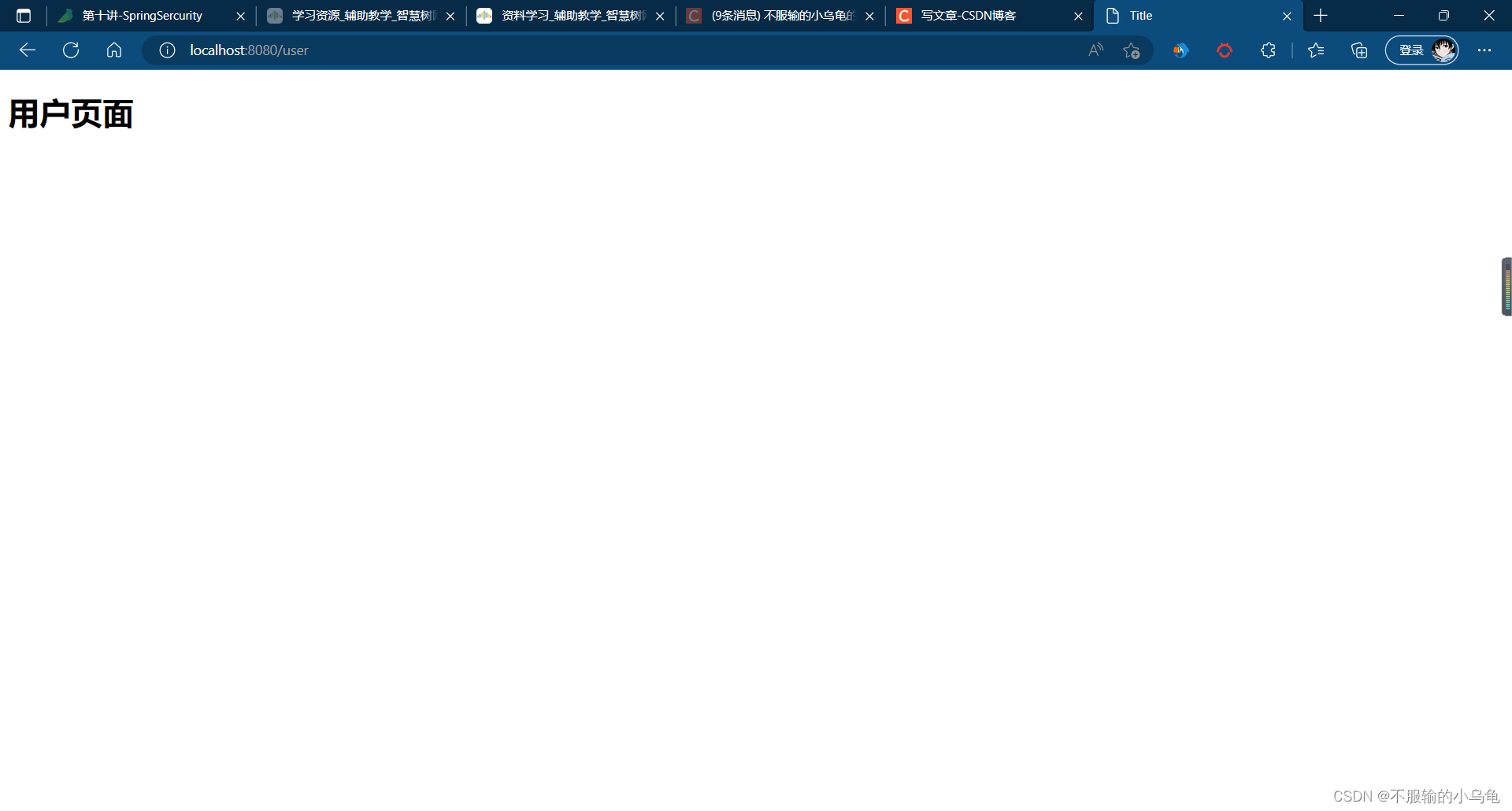

二、数据库认证:从数据库中获取用户名和密码进行验证
1、在utils文件夹下新建MyUserService类
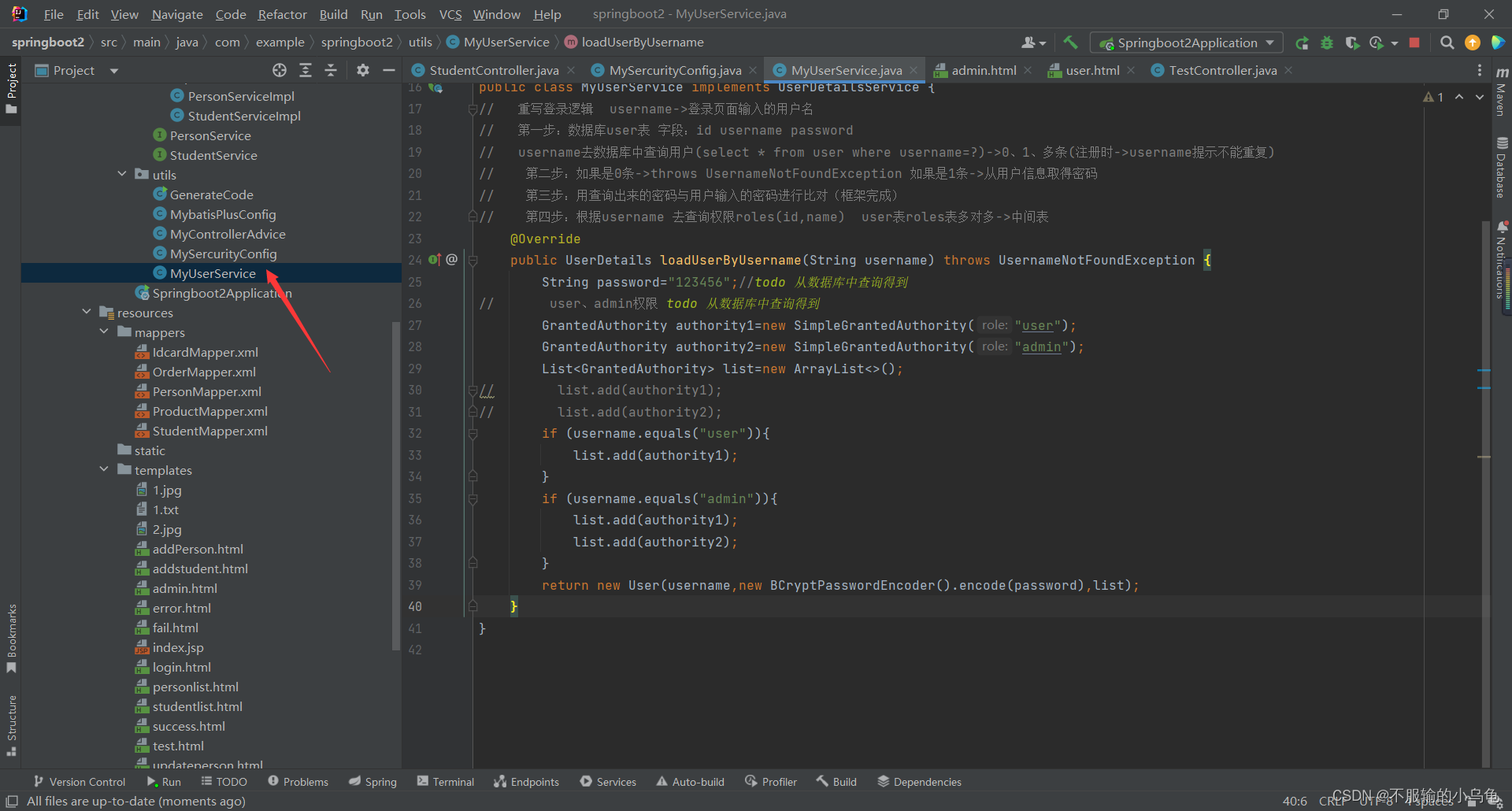
package com.example.springboot2.utils;
import org.springframework.security.core.GrantedAuthority;
import org.springframework.security.core.authority.SimpleGrantedAuthority;
import org.springframework.security.core.userdetails.User;
import org.springframework.security.core.userdetails.UserDetails;
import org.springframework.security.core.userdetails.UserDetailsService;
import org.springframework.security.core.userdetails.UsernameNotFoundException;
import org.springframework.security.crypto.bcrypt.BCryptPasswordEncoder;
import org.springframework.stereotype.Service;
import java.util.ArrayList;
import java.util.List;
@Service
public class MyUserService implements UserDetailsService {
// 重写登录逻辑 username->登录页面输入的用户名
// 第一步:数据库user表 字段:id username password
// username去数据库中查询用户(select * from user where username=?)->0、1、多条(注册时->username提示不能重复)
// 第二步:如果是0条->throws UsernameNotFoundException 如果是1条->从用户信息取得密码
// 第三步:用查询出来的密码与用户输入的密码进行比对(框架完成)
// 第四步:根据username 去查询权限roles(id,name) user表roles表多对多->中间表
@Override
public UserDetails loadUserByUsername(String username) throws UsernameNotFoundException {
String password="123456";//todo 从数据库中查询得到
// user、admin权限 todo 从数据库中查询得到
GrantedAuthority authority1=new SimpleGrantedAuthority("user");
GrantedAuthority authority2=new SimpleGrantedAuthority("admin");
List<GrantedAuthority> list=new ArrayList<>();
if (username.equals("user")){
list.add(authority1);
}
if (username.equals("admin")){
list.add(authority1);
list.add(authority2);
}
return new User(username,new BCryptPasswordEncoder().encode(password),list);
}
}
2、修改MySercurityConfig类

package com.example.springboot2.utils;
import org.springframework.beans.factory.annotation.Autowired;
import org.springframework.context.annotation.Bean;
import org.springframework.security.config.annotation.authentication.builders.AuthenticationManagerBuilder;
import org.springframework.security.config.annotation.web.builders.HttpSecurity;
import org.springframework.security.config.annotation.web.configuration.EnableWebSecurity;
import org.springframework.security.config.annotation.web.configuration.WebSecurityConfigurerAdapter;
import org.springframework.security.crypto.bcrypt.BCryptPasswordEncoder;
import org.springframework.security.crypto.password.PasswordEncoder;
@EnableWebSecurity
public class MySercurityConfig extends WebSecurityConfigurerAdapter {
// 认证
// 认证->从数据库中获取用户名和密码进行验证
@Autowired
MyUserService myUserService;
@Override
protected void configure(AuthenticationManagerBuilder auth) throws Exception{
auth.userDetailsService(myUserService).passwordEncoder(new BCryptPasswordEncoder());
// auth.inMemoryAuthentication()
// .withUser("user")
// .password(new BCryptPasswordEncoder().encode("123456"))
// .authorities("user")
// .and()
// .withUser("admin")
// .password(new BCryptPasswordEncoder().encode("123456"))
// .authorities("user","admin");//权限->字符串 ->页面(配置权限)
}
@Bean
PasswordEncoder passwordEncoder(){
return new BCryptPasswordEncoder();
}
// 授权
@Override
protected void configure(HttpSecurity http) throws Exception {
http.authorizeHttpRequests()//拦截所有请求
.antMatchers("/home","/login").permitAll()//某些请求不需要登录->放行某些接口
.antMatchers("/user").hasAuthority("user")//对页面配置权限
.antMatchers("/admin").hasAuthority("admin")
.anyRequest().authenticated();//其他的接口拦截
http.formLogin();//拦截后跳转到表单页面
}
}
3、点击运行,登录user用户可以访问user页面,但不可以访问admin页面;登录admin用户既可以访问user页面,也可以访问admin页面
(1)登录user用户

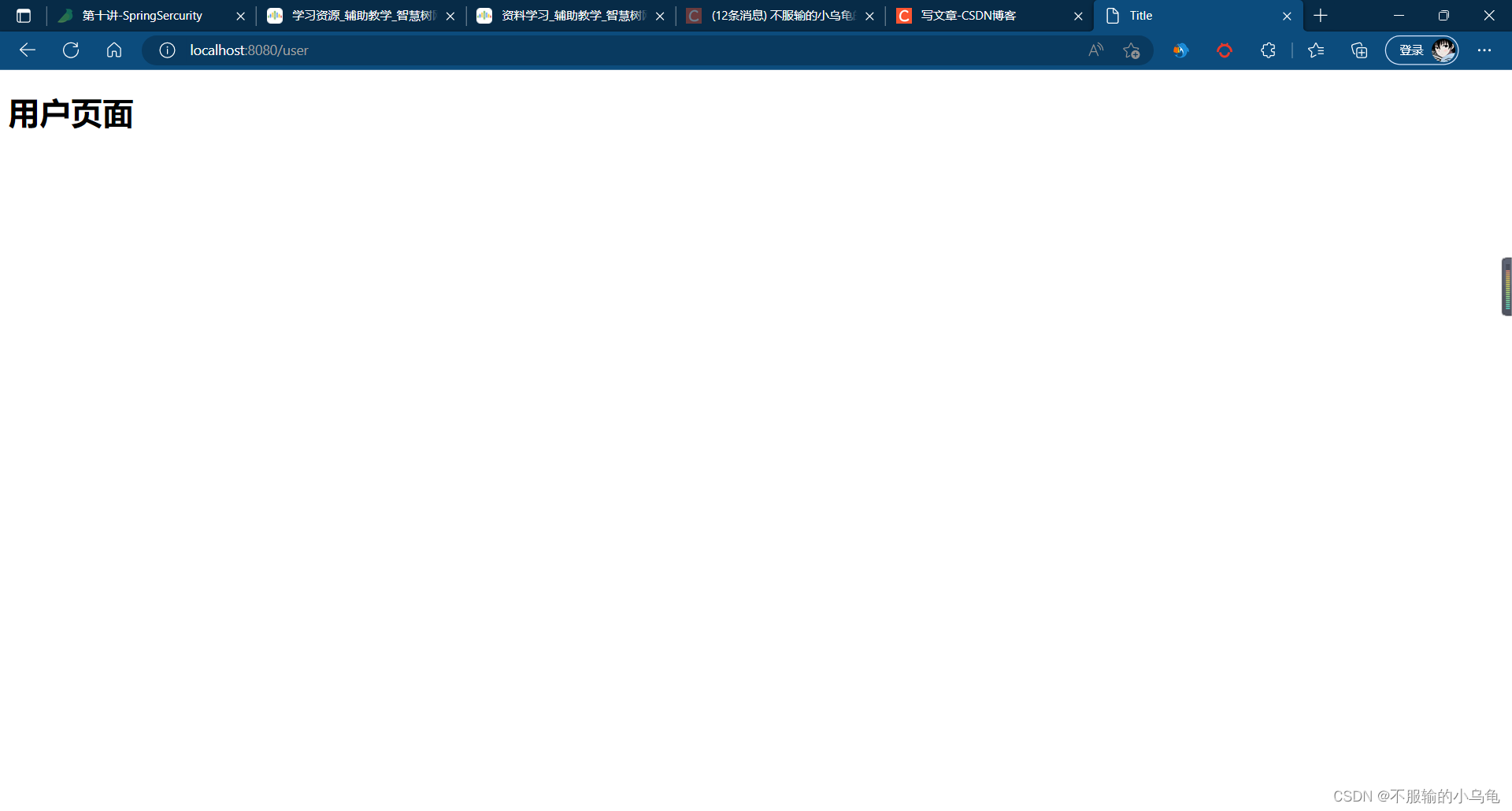
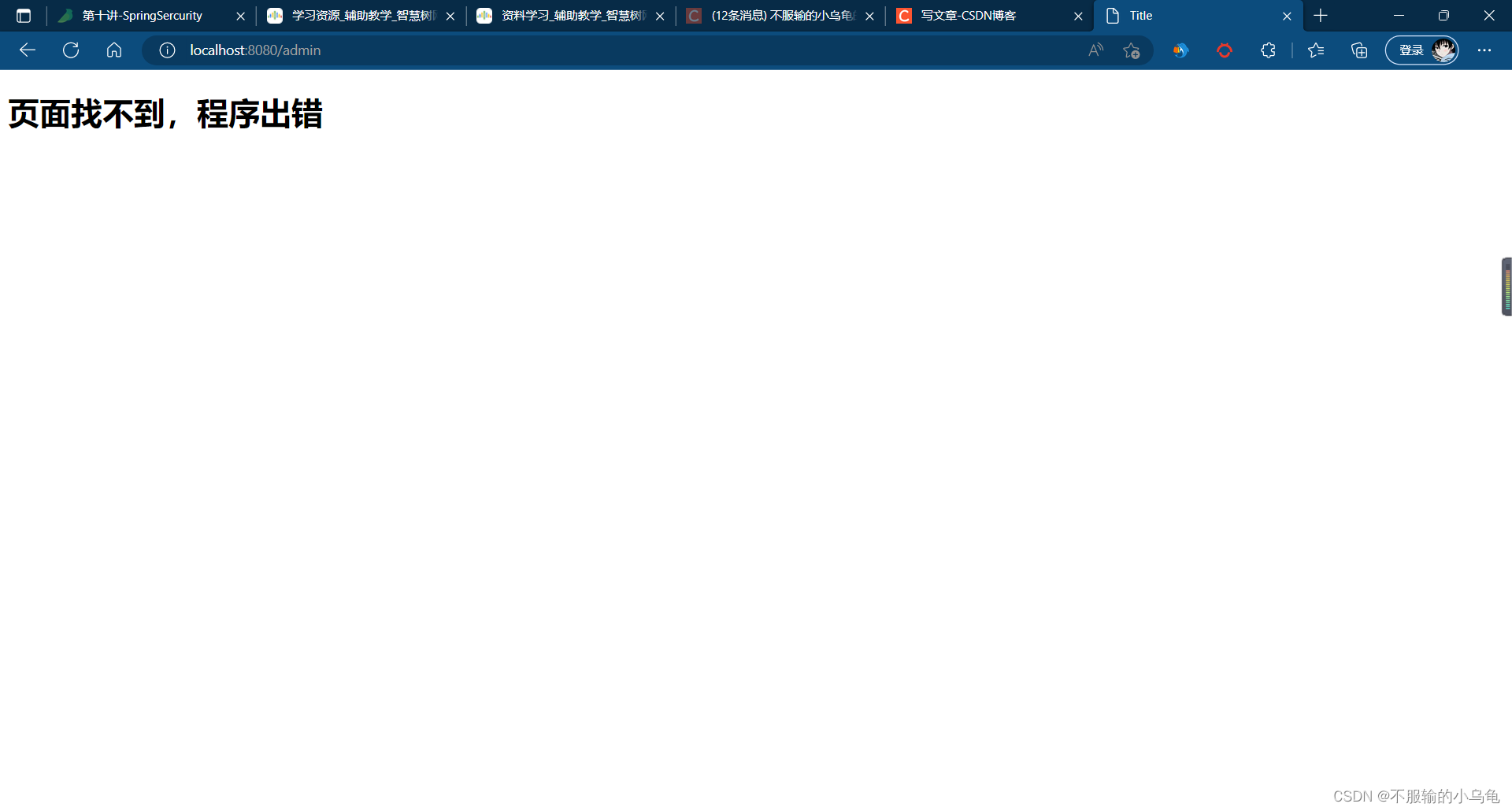
(2)登录admin用户
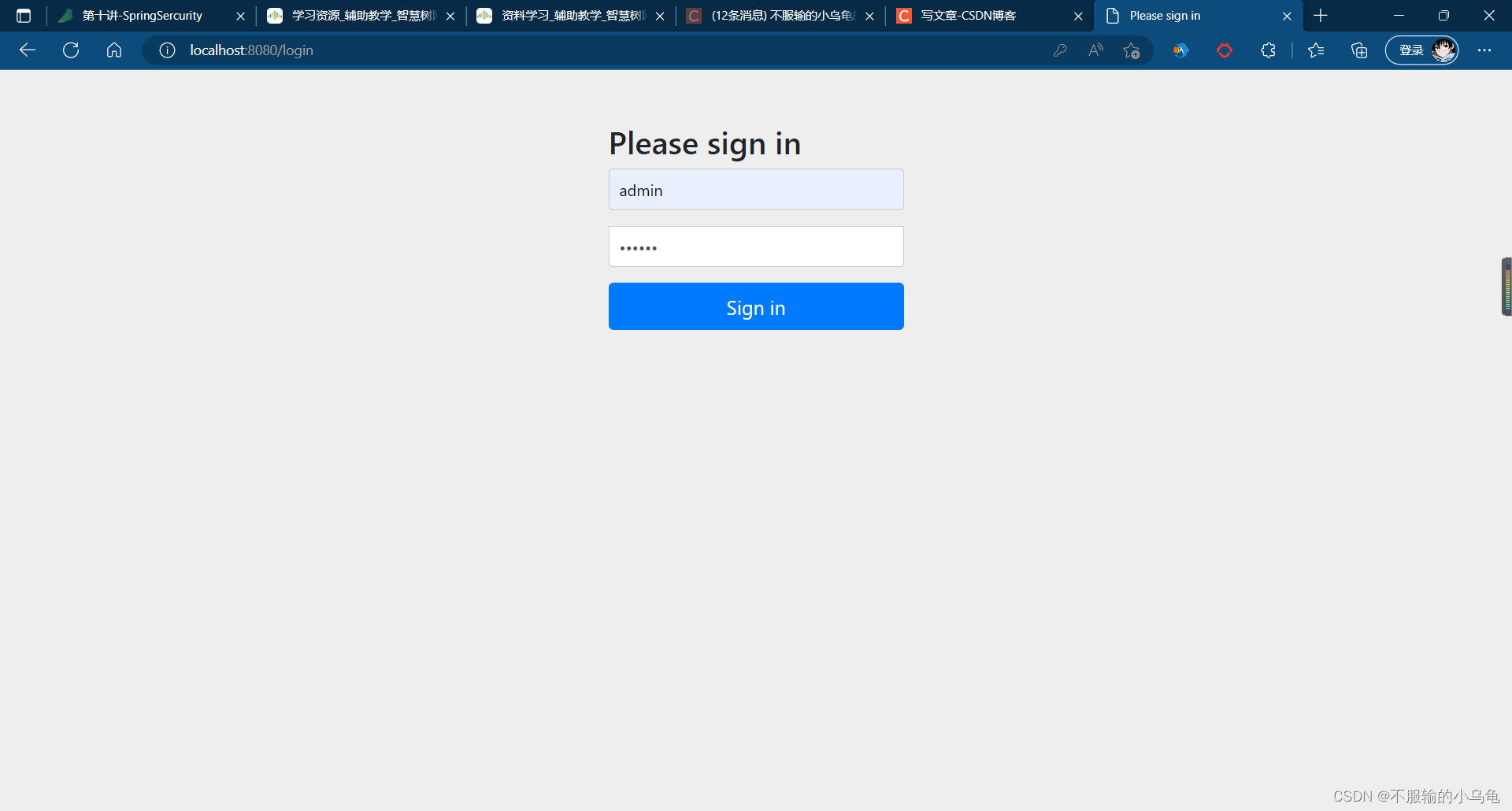

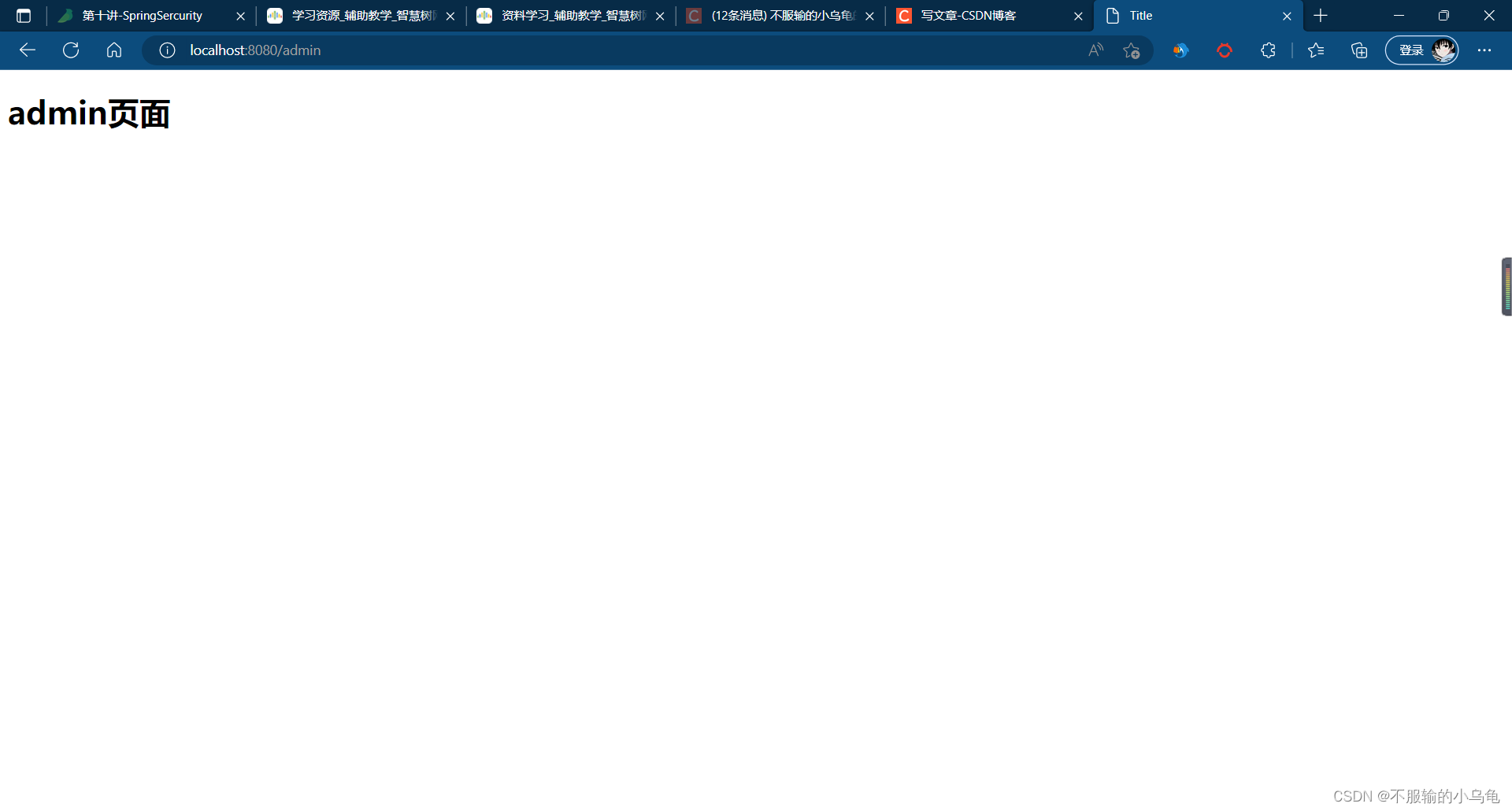
三、自定义登录页面
1、修改MySercurityConfig类
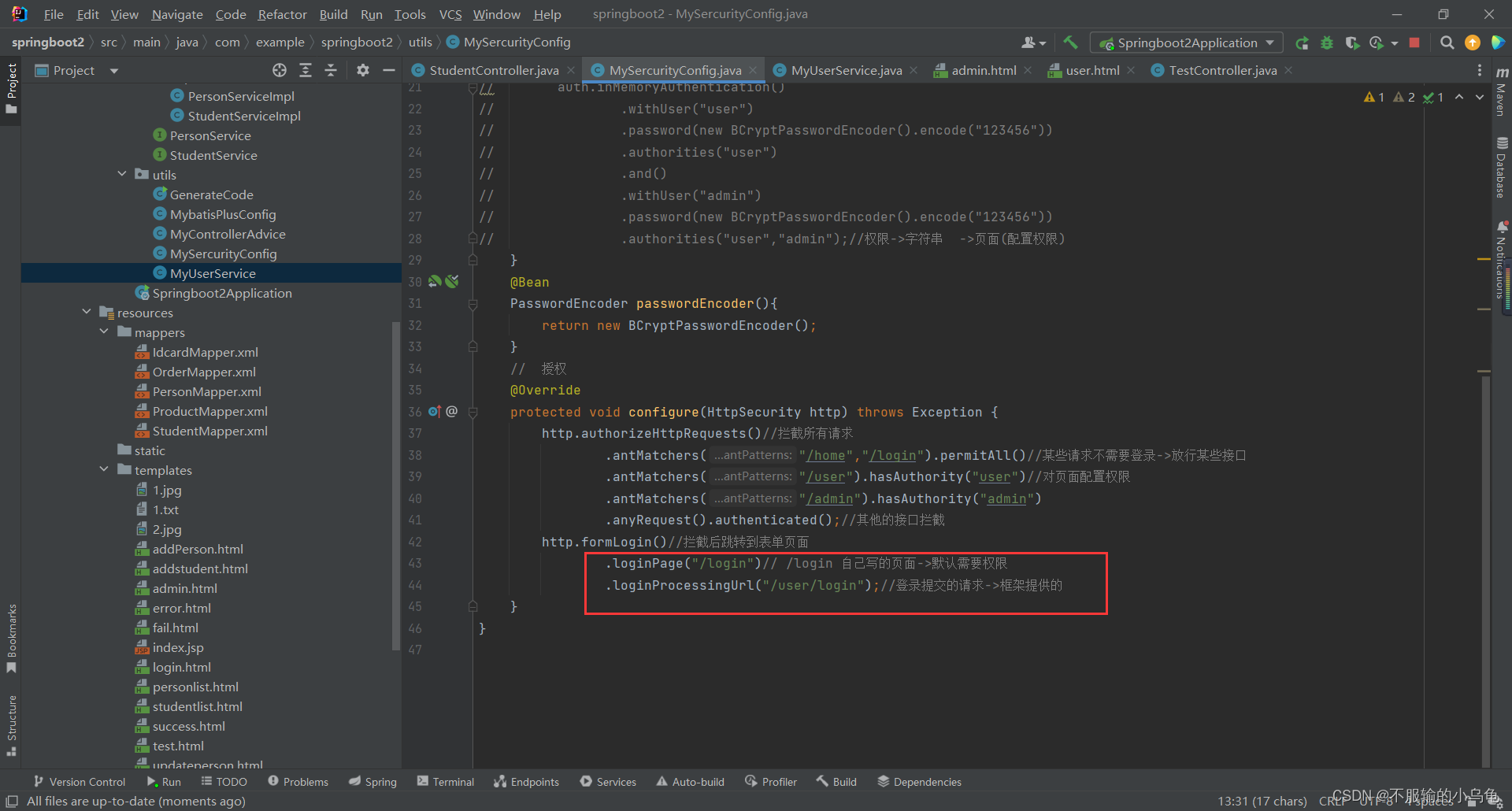
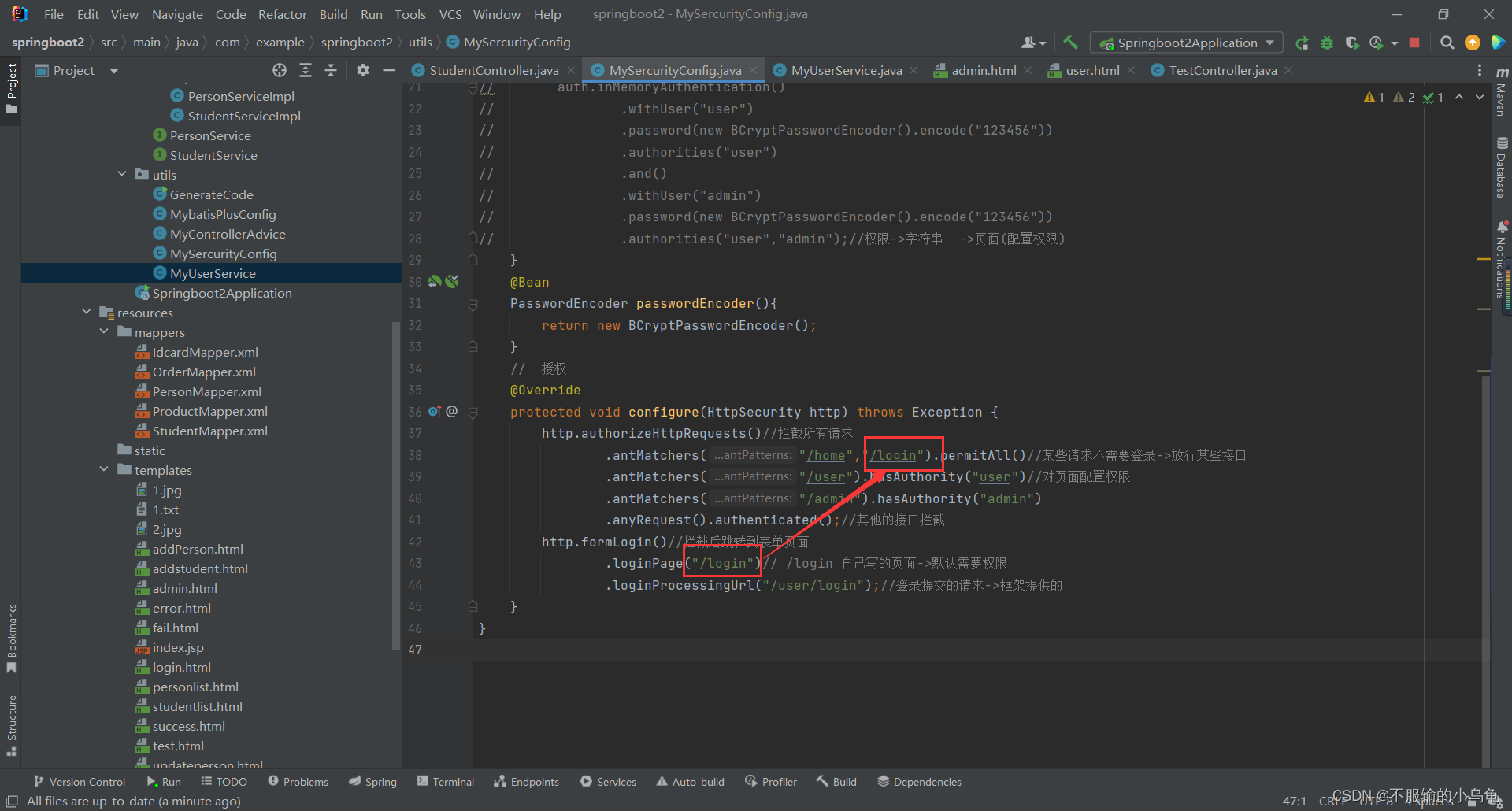
// 授权
@Override
protected void configure(HttpSecurity http) throws Exception {
http.authorizeHttpRequests()//拦截所有请求
.antMatchers("/home","/login").permitAll()//某些请求不需要登录->放行某些接口
.antMatchers("/user").hasAuthority("user")//对页面配置权限
.antMatchers("/admin").hasAuthority("admin")
.anyRequest().authenticated();//其他的接口拦截
http.formLogin()//拦截后跳转到表单页面
.loginPage("/login")// /login 自己写的页面->默认需要权限
.loginProcessingUrl("/user/login");//登录提交的请求->框架提供的
}
2、修改login.html
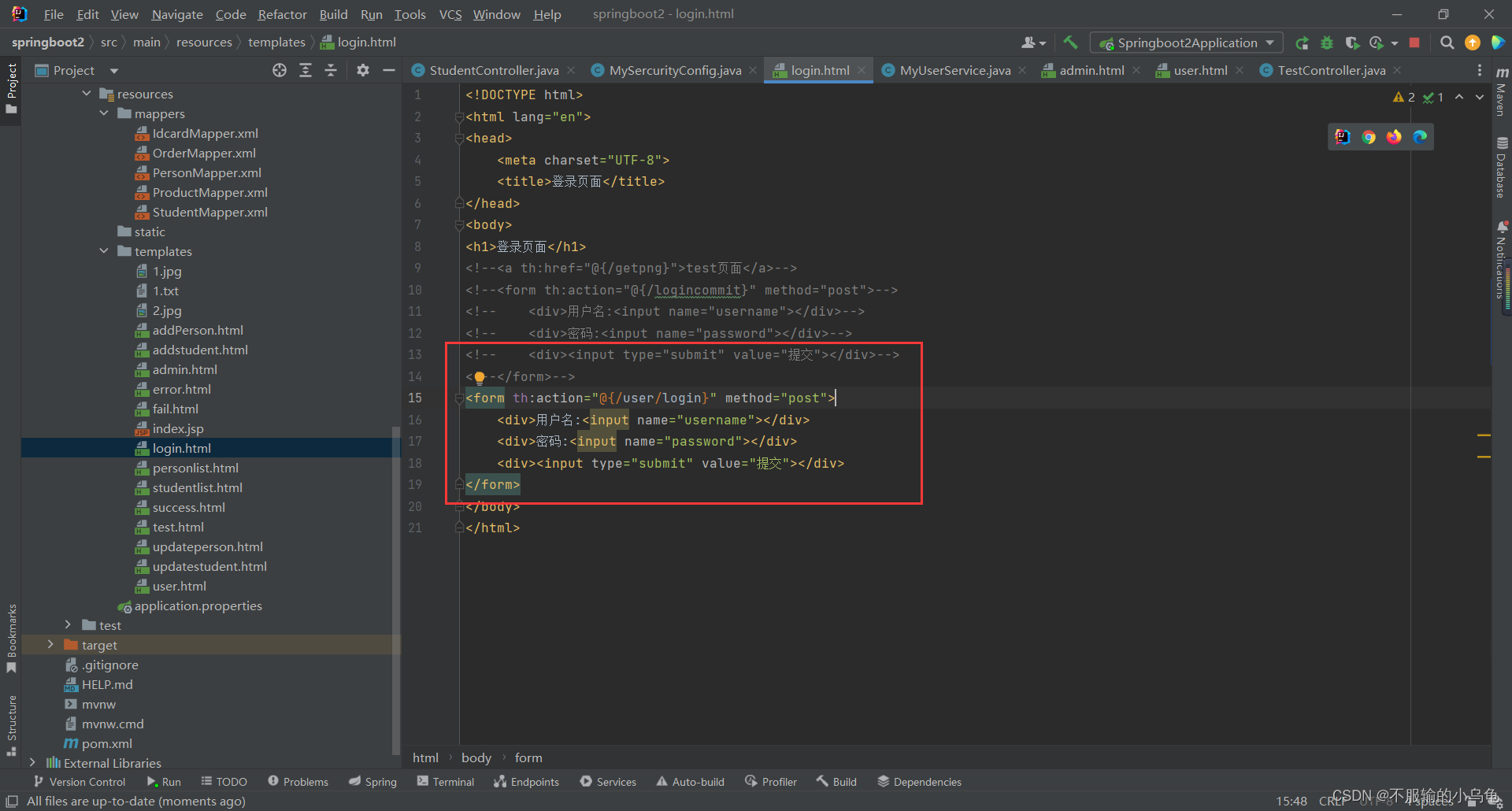
<!DOCTYPE html>
<html lang="en">
<head>
<meta charset="UTF-8">
<title>登录页面</title>
</head>
<body>
<h1>登录页面</h1>
<form th:action="@{/user/login}" method="post">
<div>用户名:<input name="username"></div>
<div>密码:<input name="password"></div>
<div><input type="submit" value="提交"></div>
</form>
</body>
</html>
3、点击运行,登录页面变成我们自定义的页面啦
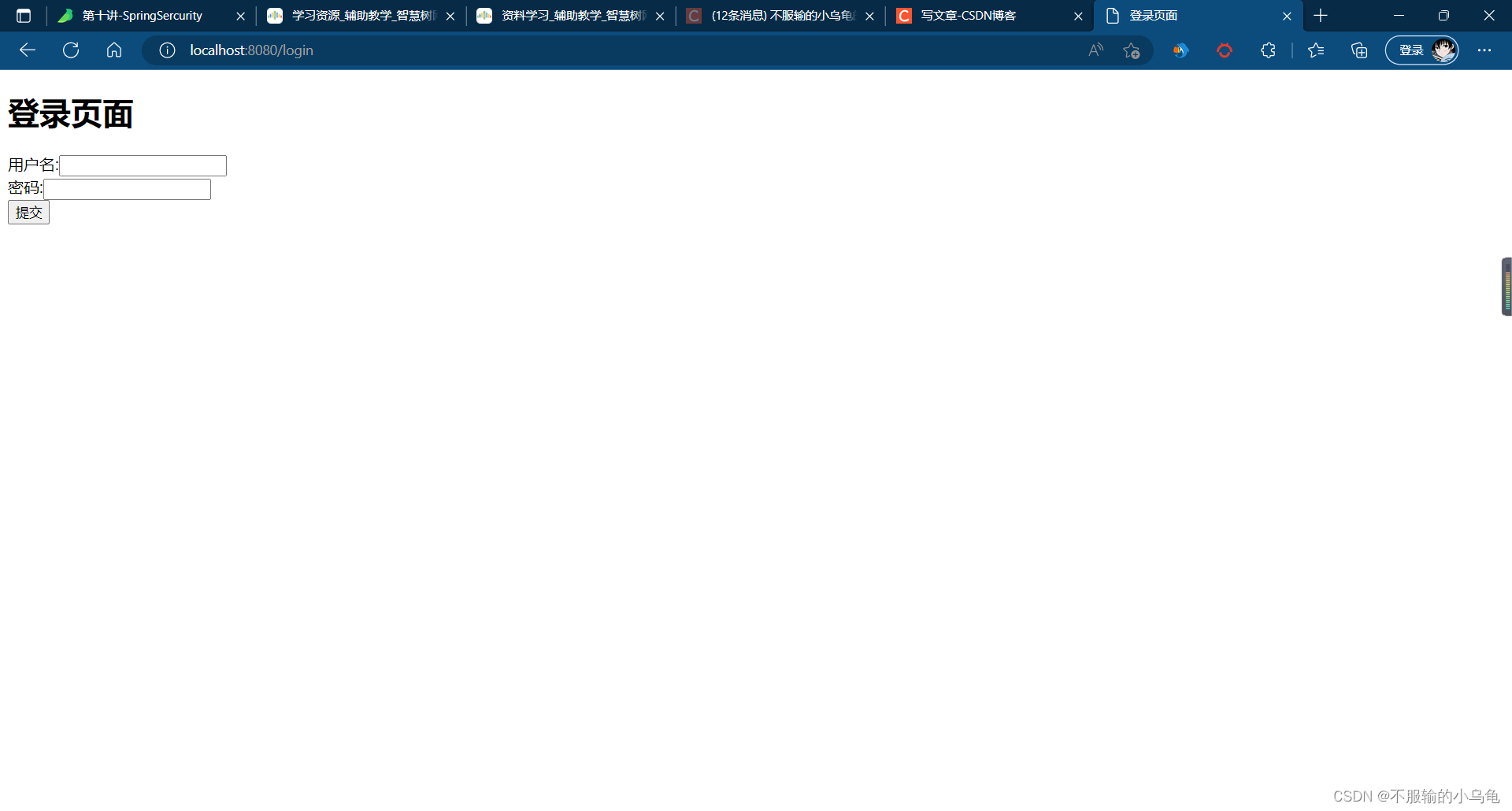
四、自定义登出页面
1、修改MySercurityConfig类
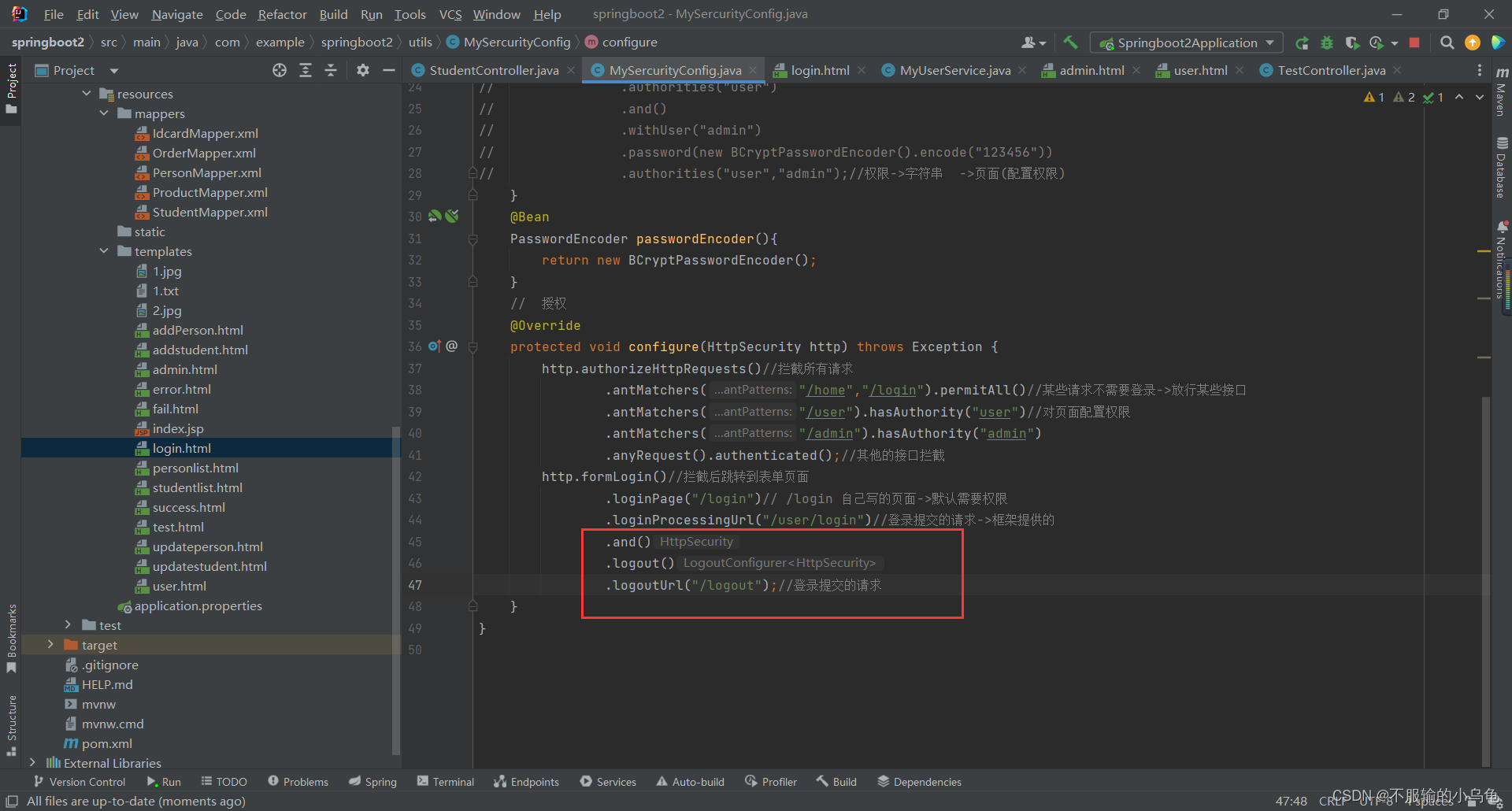
// 授权
@Override
protected void configure(HttpSecurity http) throws Exception {
http.authorizeHttpRequests()//拦截所有请求
.antMatchers("/home","/login").permitAll()//某些请求不需要登录->放行某些接口
.antMatchers("/user").hasAuthority("user")//对页面配置权限
.antMatchers("/admin").hasAuthority("admin")
.anyRequest().authenticated();//其他的接口拦截
http.formLogin()//拦截后跳转到表单页面
.loginPage("/login")// /login 自己写的页面->默认需要权限
.loginProcessingUrl("/user/login")//登录提交的请求->框架提供的
.and()
.logout()
.logoutUrl("/logout");//登录提交的请求
}
2、在templates文件夹下新建mylogout.html

<!DOCTYPE html>
<html lang="en">
<head>
<meta charset="UTF-8">
<title>退出登录页面</title>
</head>
<body>
<!--框架提供的登出接口-->
<!--/user/login ->security提供登录验证接口-->
<h1>你确定要退出吗?</h1>
<form th:action="@{/logout}" method="post">
<button>退出登录</button>
</form>
</body>
</html>
3、修改TestController类
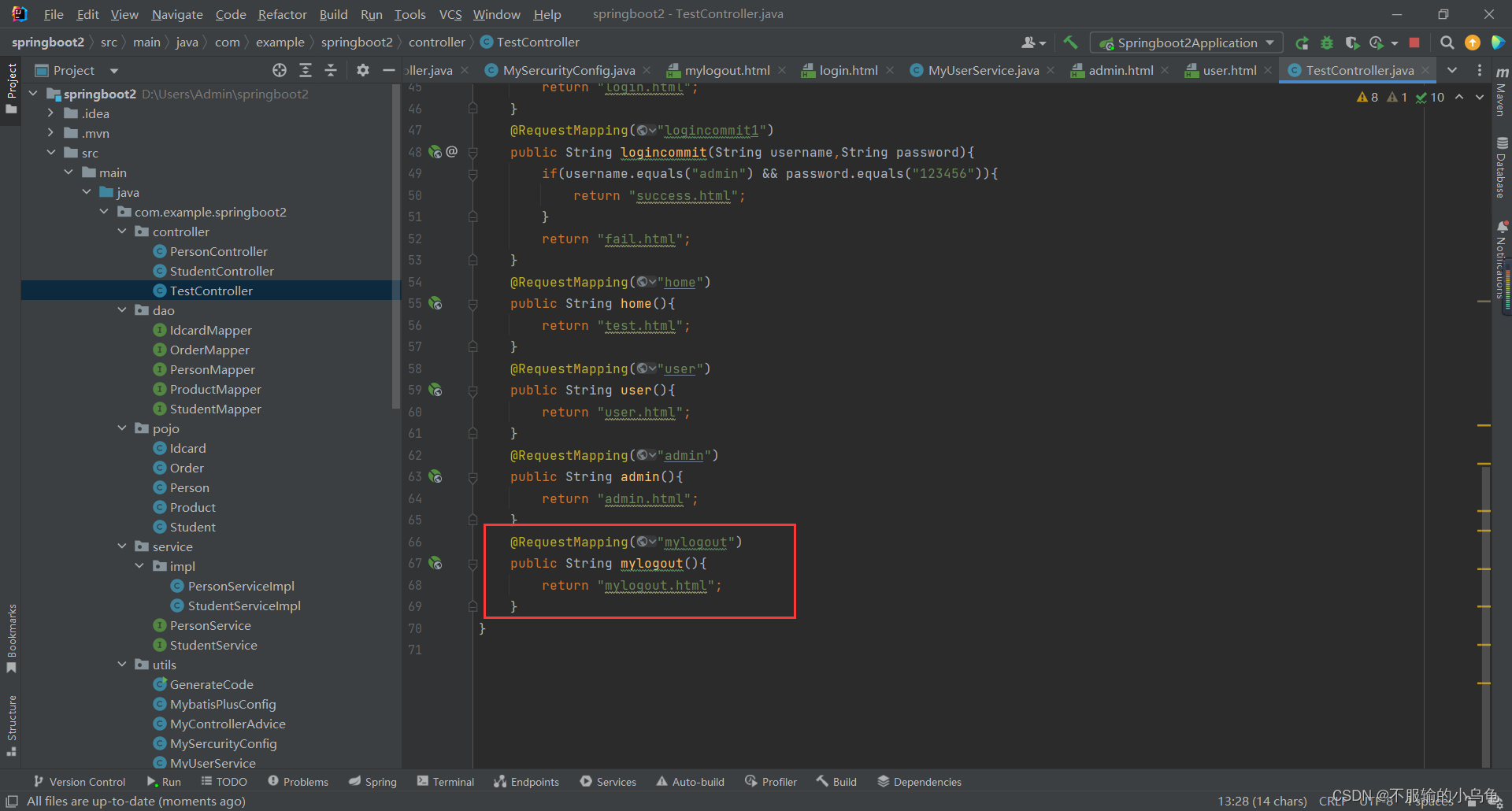
@RequestMapping("mylogout")
public String mylogout(){
return "mylogout.html";
}
4、点击运行,登出页面也变为我们自定义的页面啦,退出登录后回到登录页面
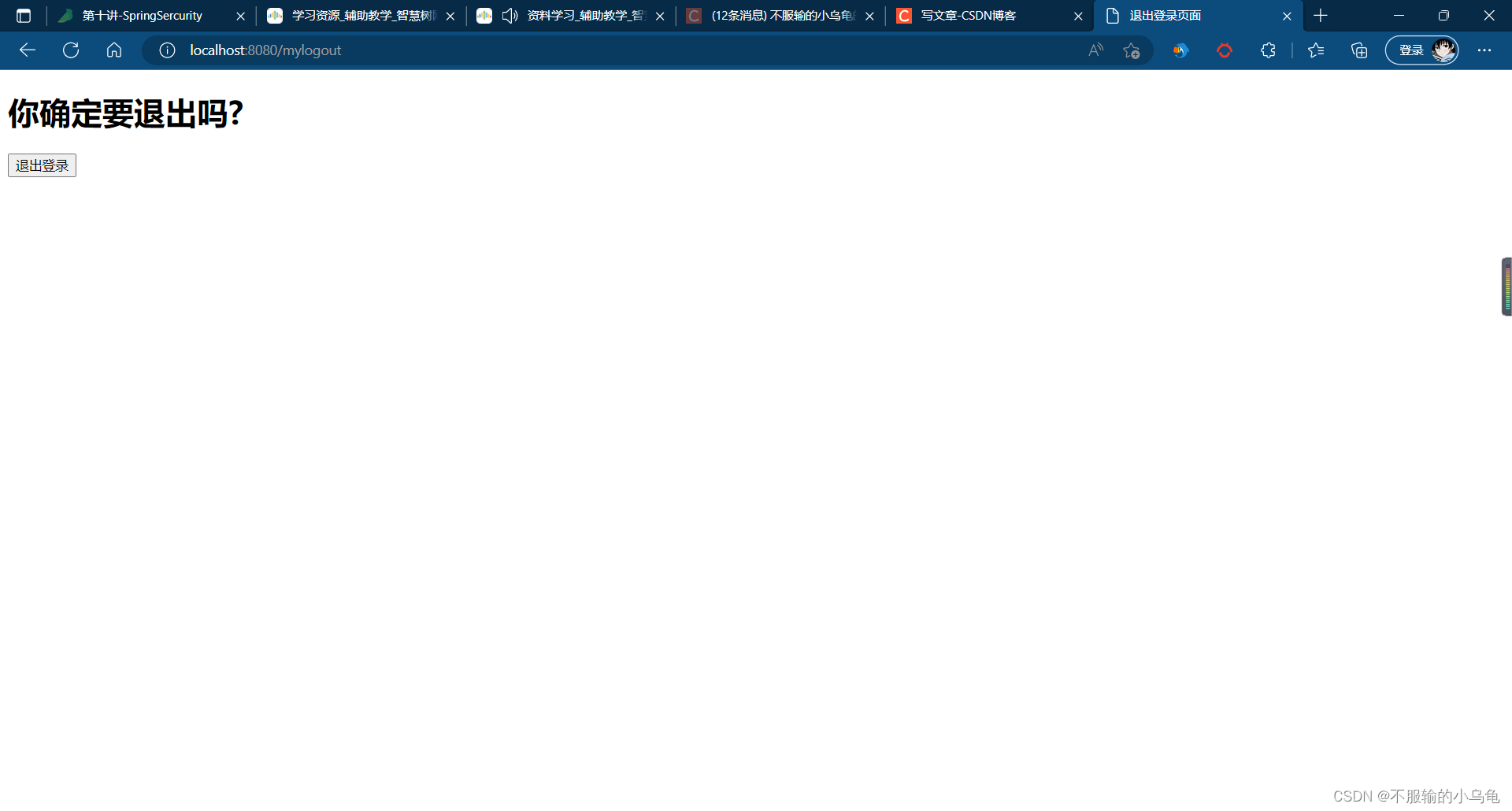
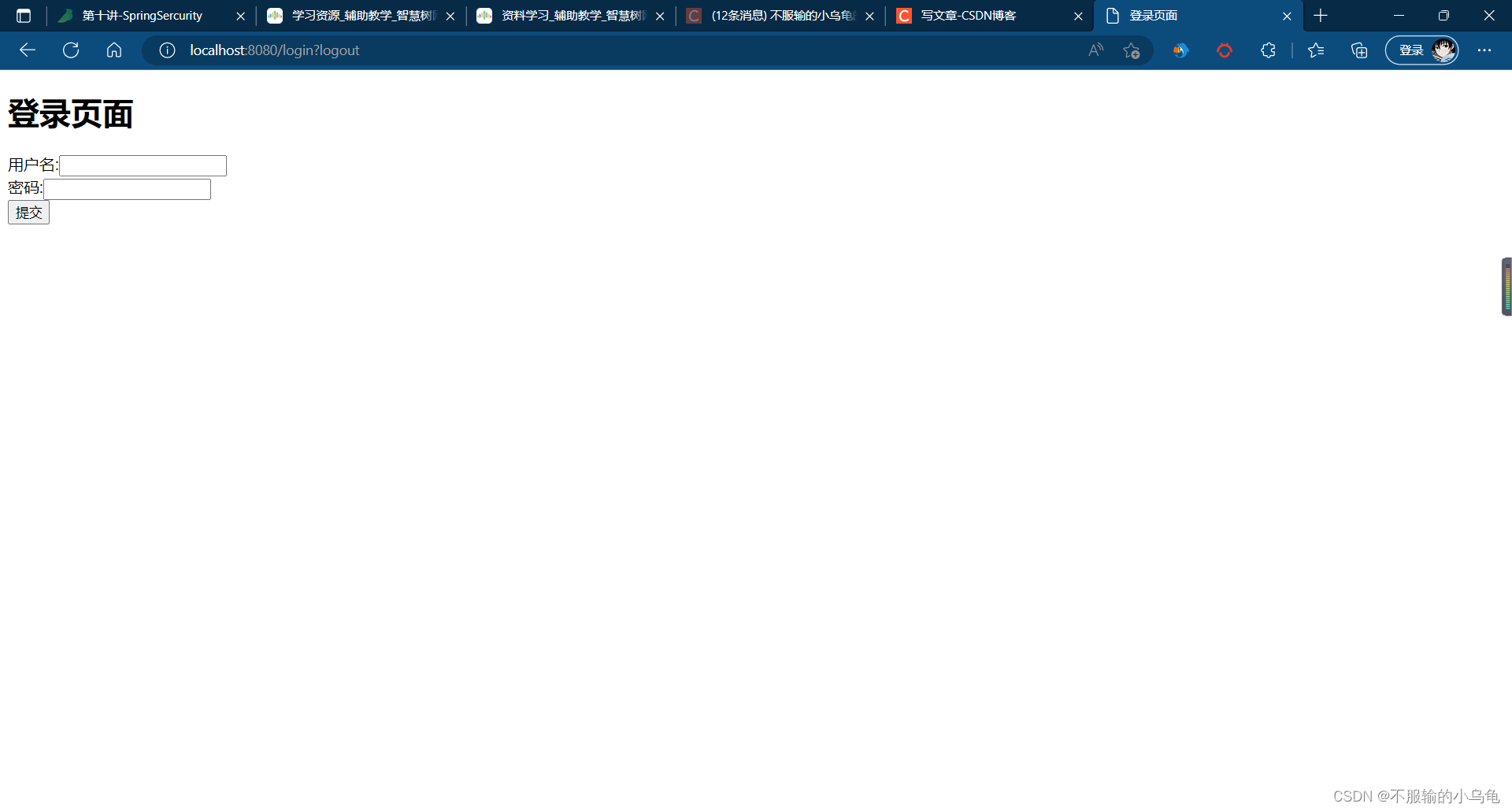
五、文件上传
1、修改application.properties

spring.web.resources.static-locations=classpath:/templates,file:D:/data/
2、在templates文件夹下新建file.html
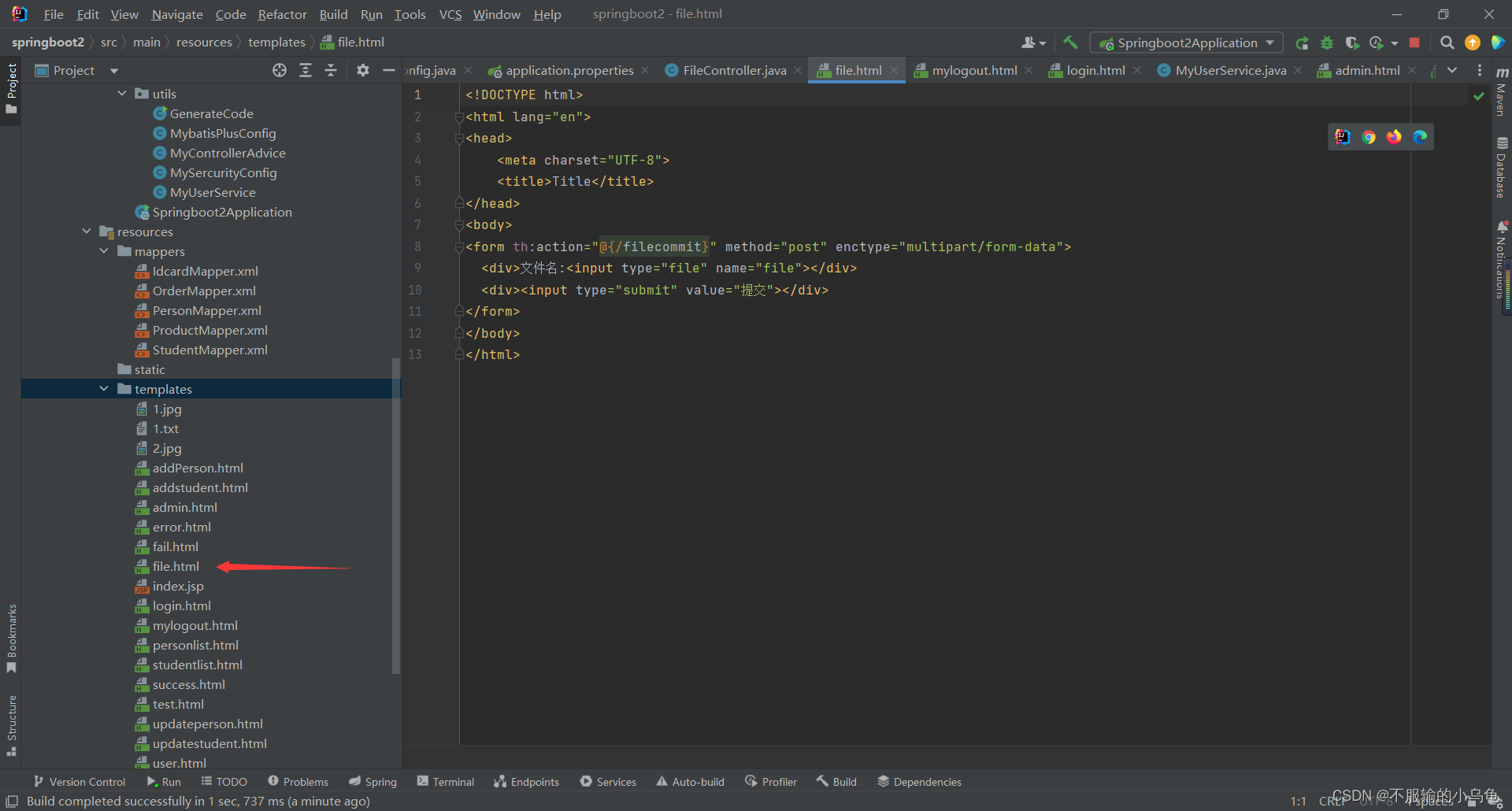
<!DOCTYPE html>
<html lang="en">
<head>
<meta charset="UTF-8">
<title>Title</title>
</head>
<body>
<form th:action="@{/filecommit}" method="post" enctype="multipart/form-data">
<div>文件名:<input type="file" name="file"></div>
<div><input type="submit" value="提交"></div>
</form>
</body>
</html>
3、在controller文件夹下新建FileController类
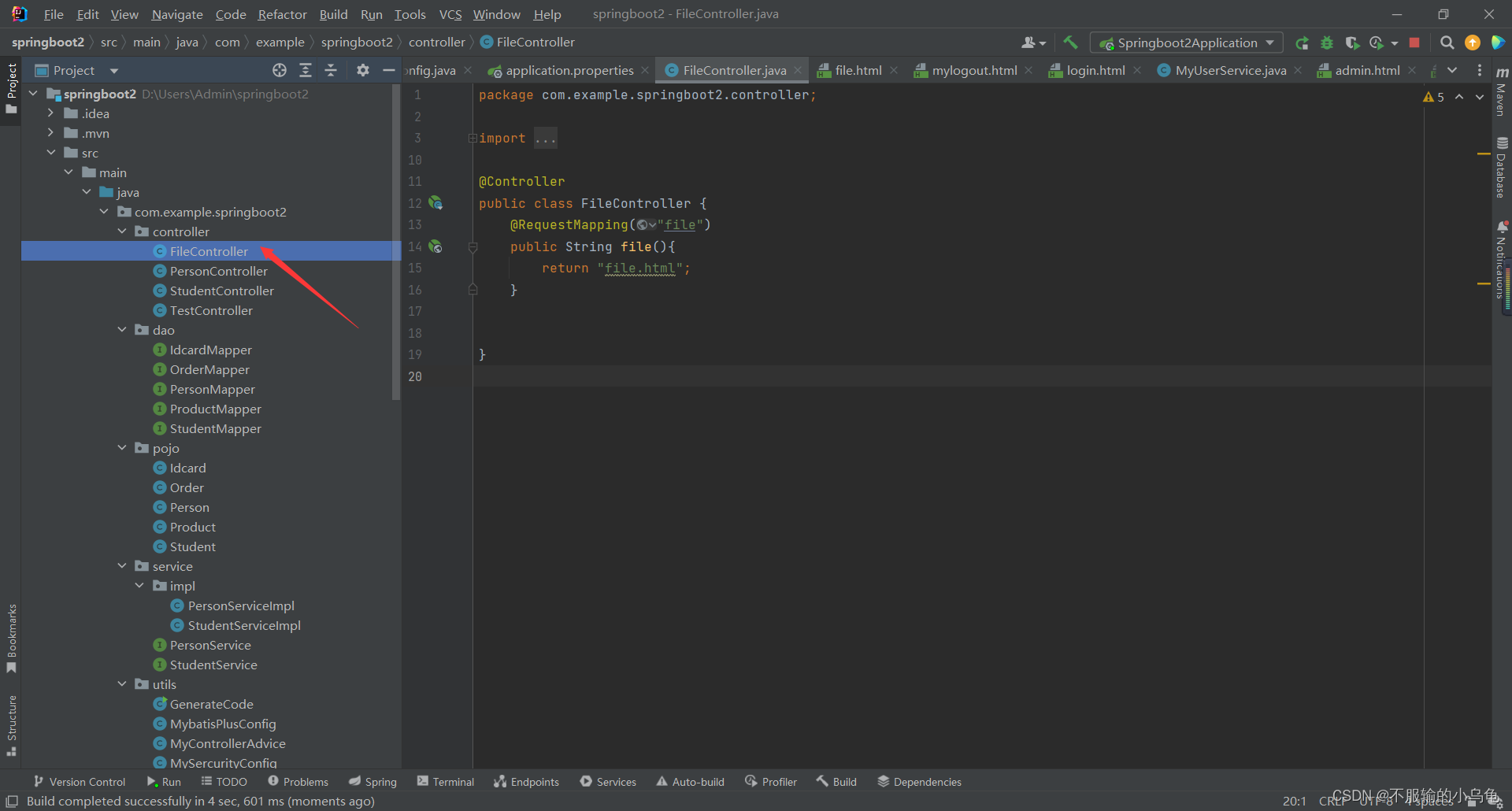
package com.example.springboot2.controller;
import org.springframework.stereotype.Controller;
import org.springframework.web.bind.annotation.RequestMapping;
import org.springframework.web.multipart.MultipartFile;
import java.io.File;
import java.io.IOException;
import java.util.UUID;
@Controller
public class FileController {
@RequestMapping("file")
public String file(){
return "file.html";
}
}
4、点击运行,选择文件成功


5、修改MySercurityConfig类,设置"/**"放行所有接口
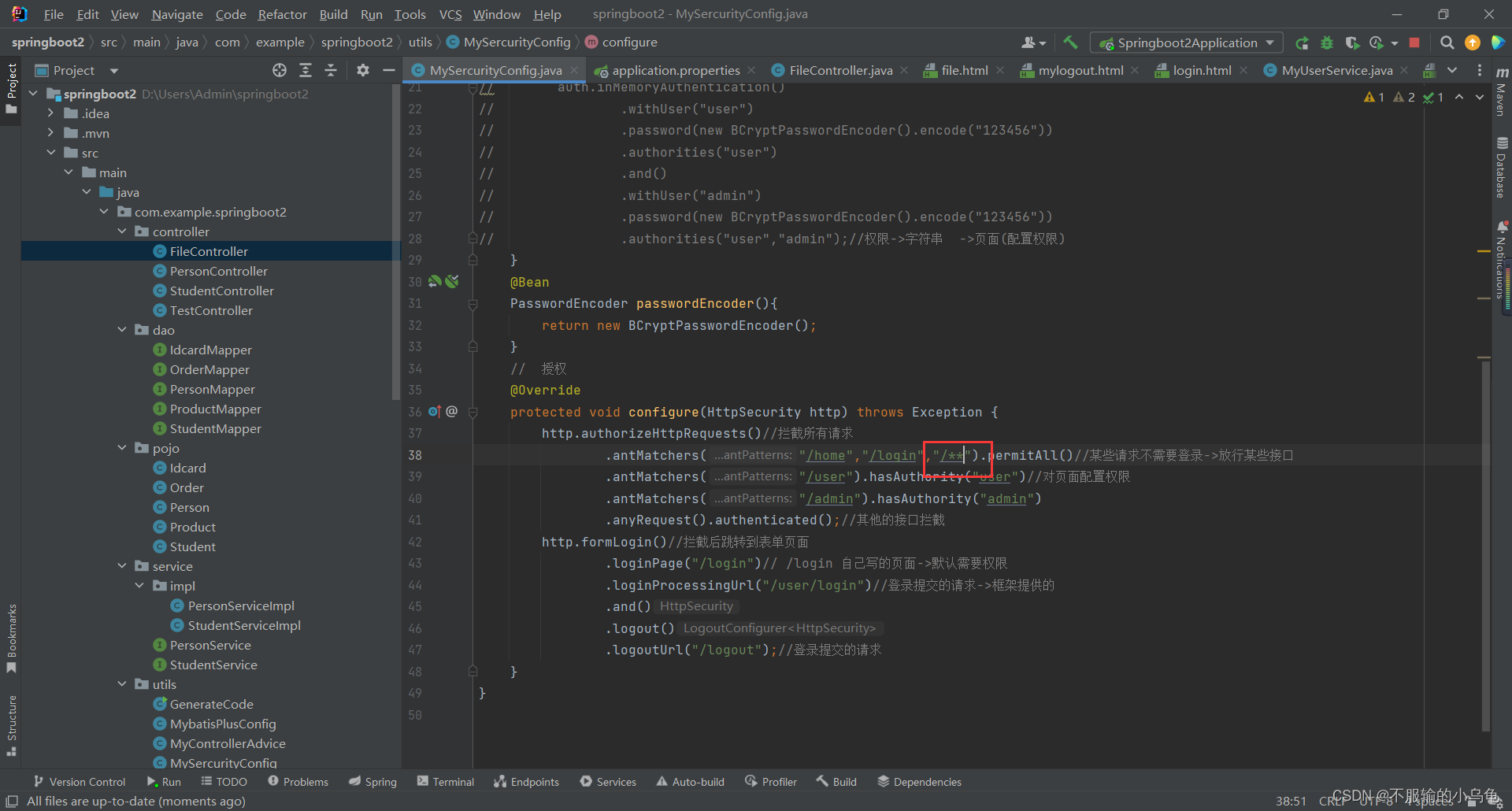
// 授权
@Override
protected void configure(HttpSecurity http) throws Exception {
http.authorizeHttpRequests()//拦截所有请求
.antMatchers("/home","/login","/**").permitAll()//某些请求不需要登录->放行某些接口
.antMatchers("/user").hasAuthority("user")//对页面配置权限
.antMatchers("/admin").hasAuthority("admin")
.anyRequest().authenticated();//其他的接口拦截
http.formLogin()//拦截后跳转到表单页面
.loginPage("/login")// /login 自己写的页面->默认需要权限
.loginProcessingUrl("/user/login")//登录提交的请求->框架提供的
.and()
.logout()
.logoutUrl("/logout");//登录提交的请求
}
6、修改FileController类

// 图片、音频、视频一般不直接存数据库 数据库只存文件名字和文件路径
@RequestMapping("filecommit")
public String filecommit(MultipartFile file) throws IOException {
String filedirs="D:/data/";
String filename=file.getOriginalFilename();
file.transferTo(new File(filedirs+filename));
return "success.html";
}
7、点击运行,选择文件成功提交到指定路径


8、修改FileController类,为了防止因文件名字相同而出现文件覆盖问题,将文件名设置为随机数+文件名

// 图片、音频、视频一般不直接存数据库 数据库只存文件名字和文件路径
@RequestMapping("filecommit")
public String filecommit(MultipartFile file) throws IOException {
String filedirs="D:/data/";
// String filename=file.getOriginalFilename();
String filename= UUID.randomUUID()+file.getOriginalFilename();
file.transferTo(new File(filedirs+filename));
return "success.html";
}
9、点击运行,提交两次相同文件,文件不会被覆盖
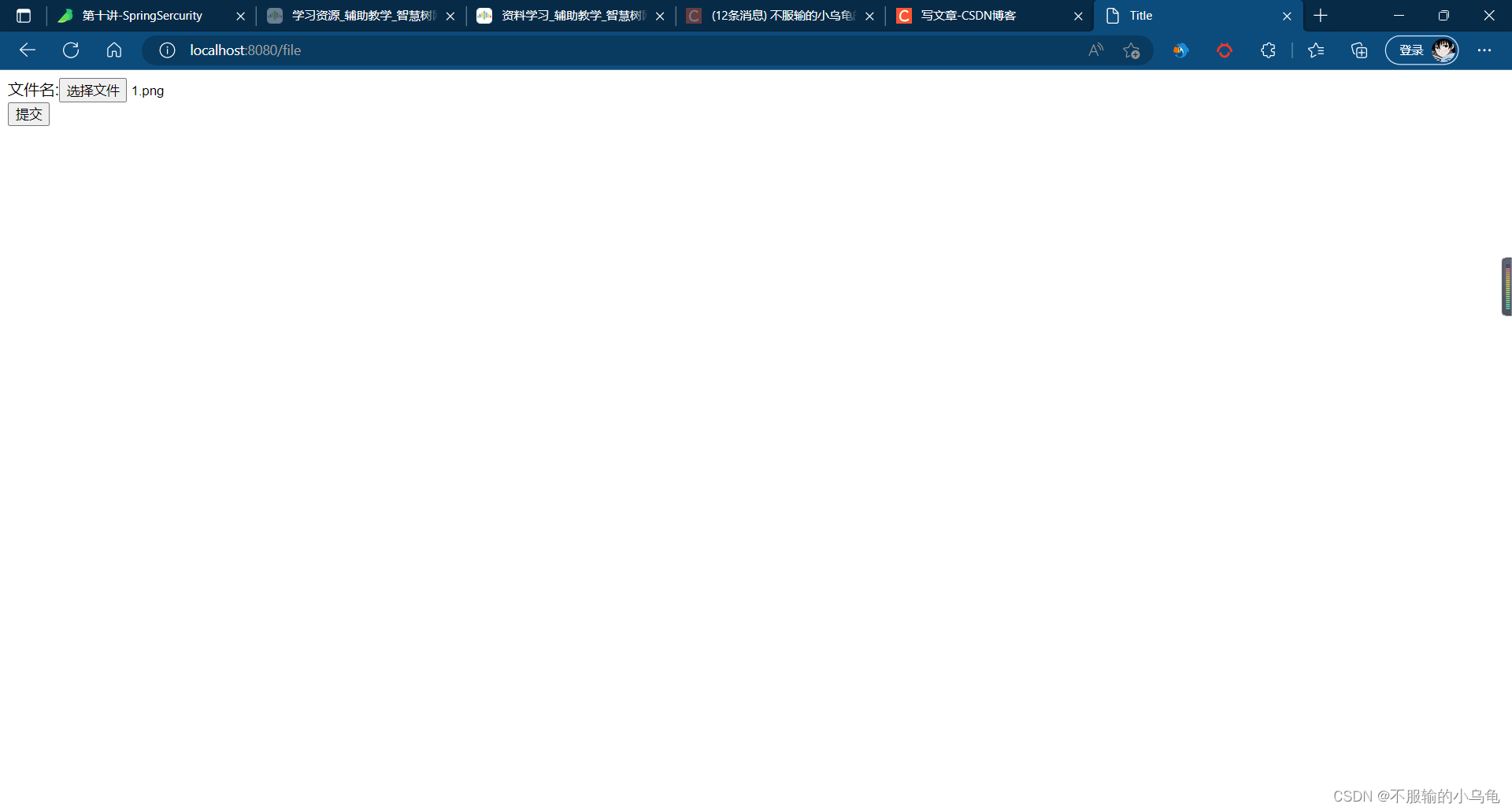
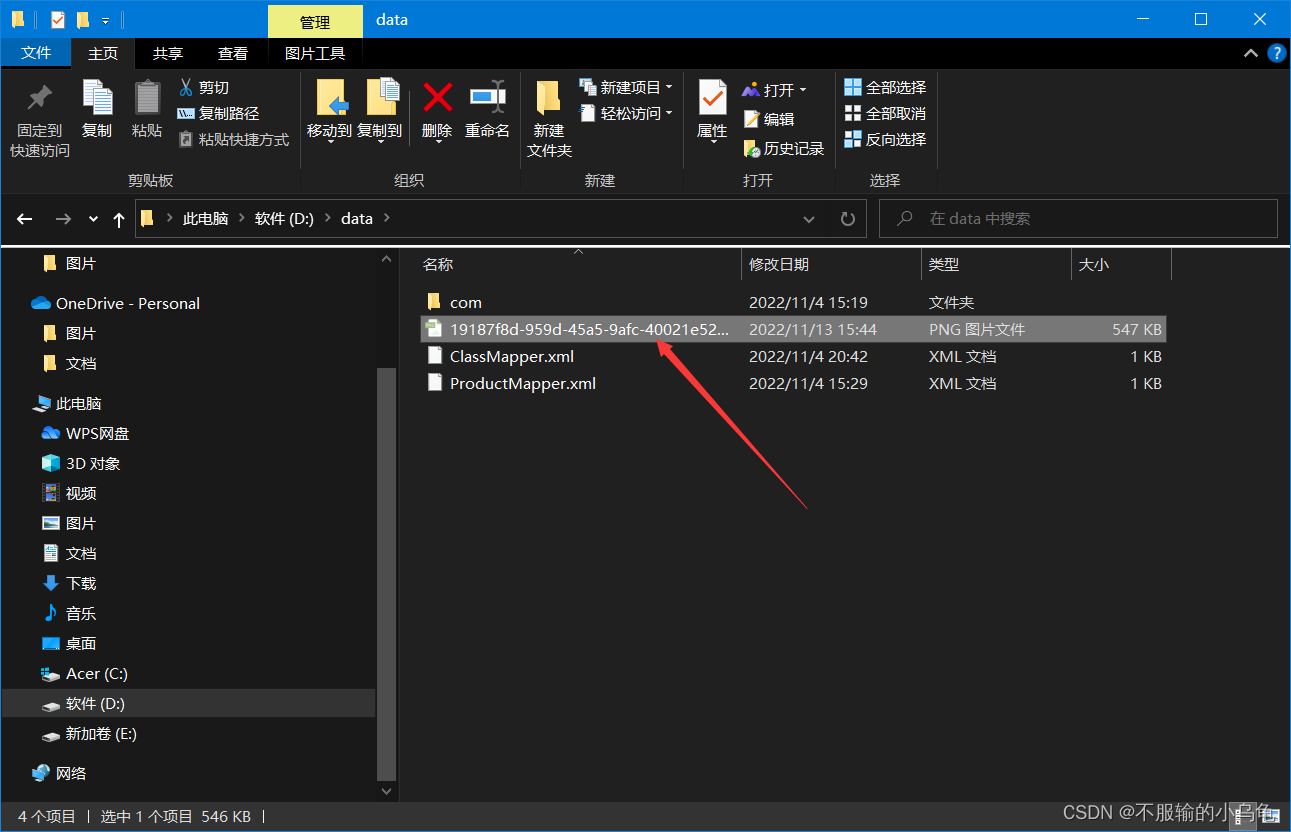
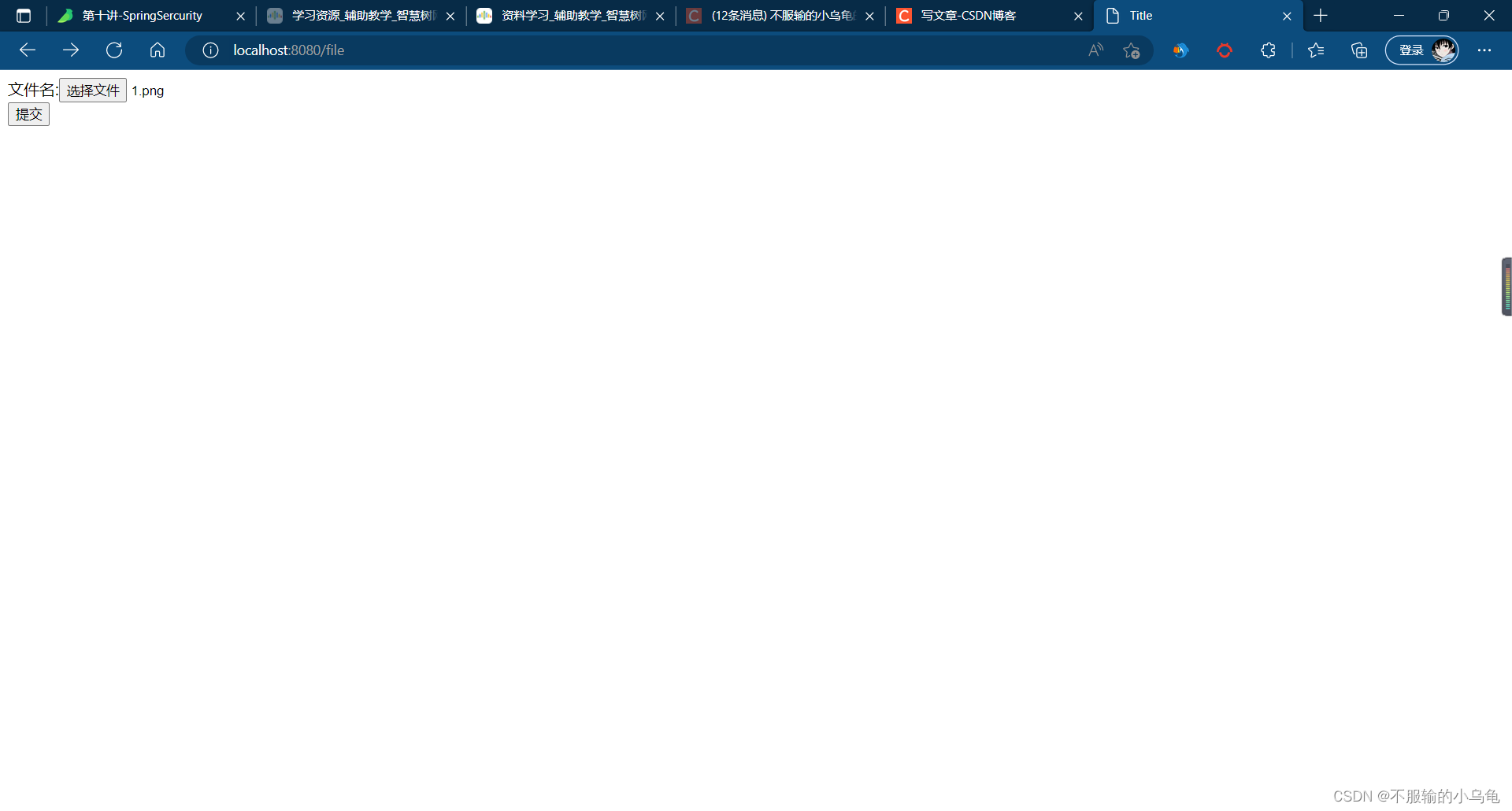
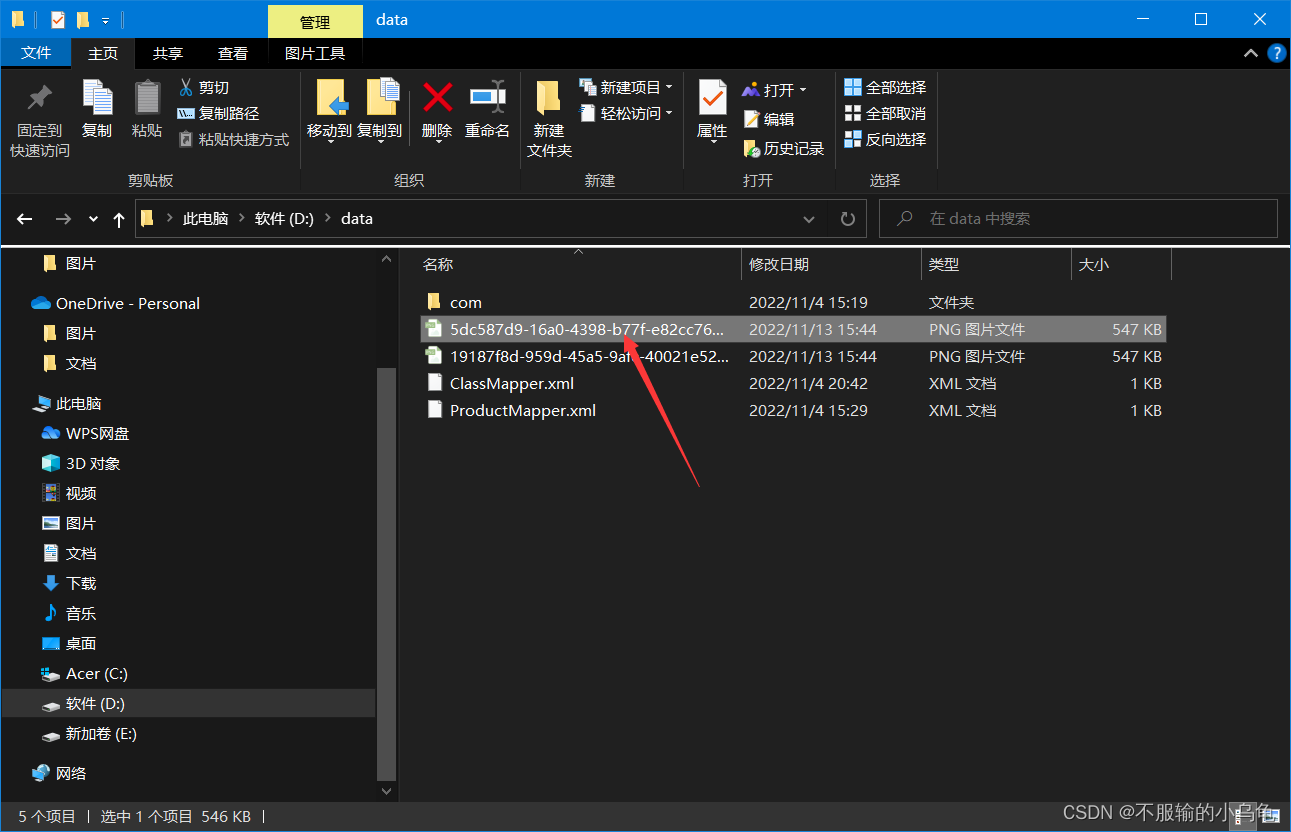
10、修改FileController类,将文件显示出来

// 图片、音频、视频一般不直接存数据库 数据库只存文件名字和文件路径
@RequestMapping("filecommit")
public String filecommit(MultipartFile file, Model model) throws IOException {
String filedirs="D:/data/";
// String filename=file.getOriginalFilename();
String filename= UUID.randomUUID()+file.getOriginalFilename();
file.transferTo(new File(filedirs+filename));
model.addAttribute("filename",filename);
return "success.html";
}
11、修改success.html
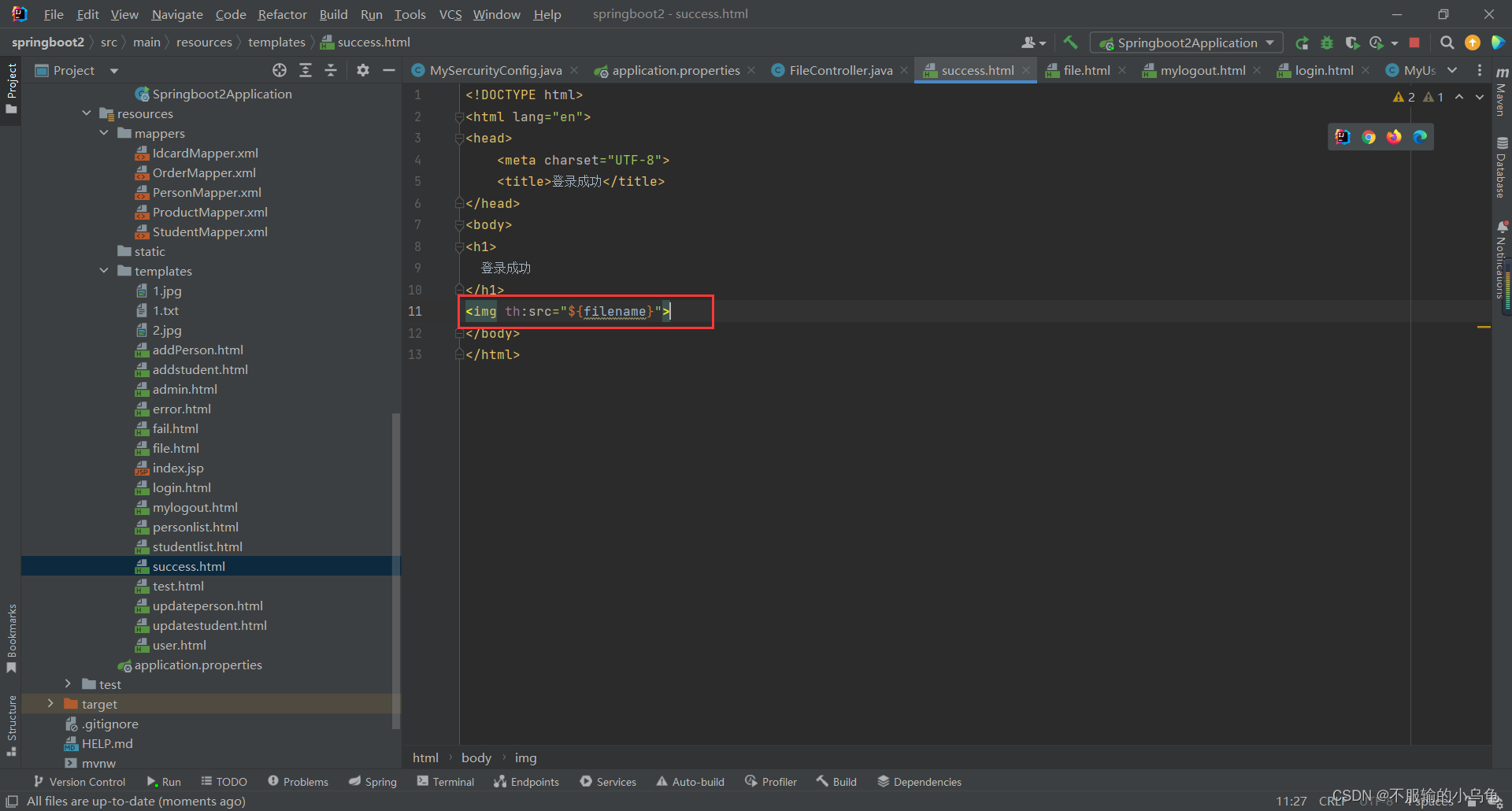
12、点击运行,显示图片成功
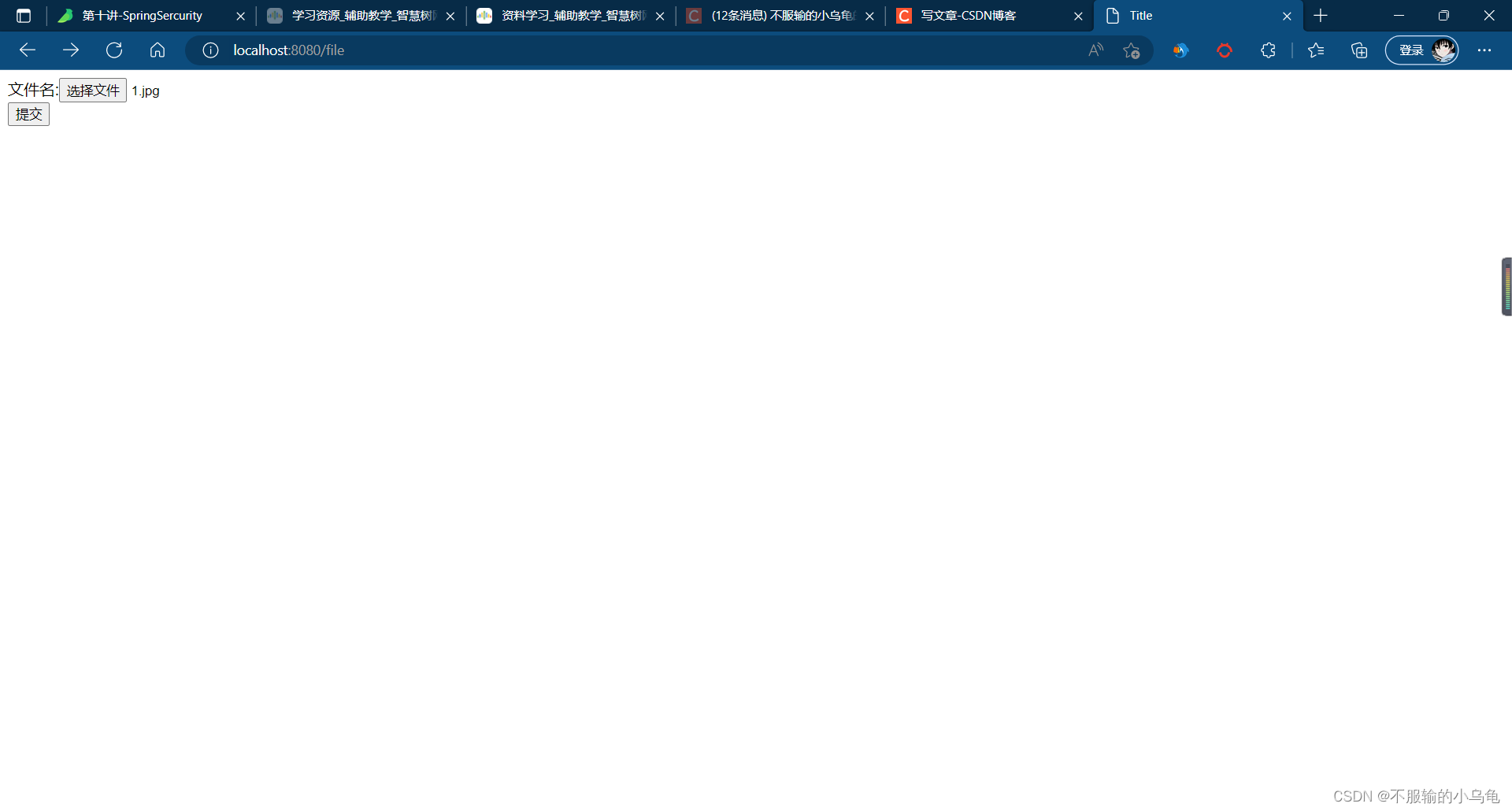
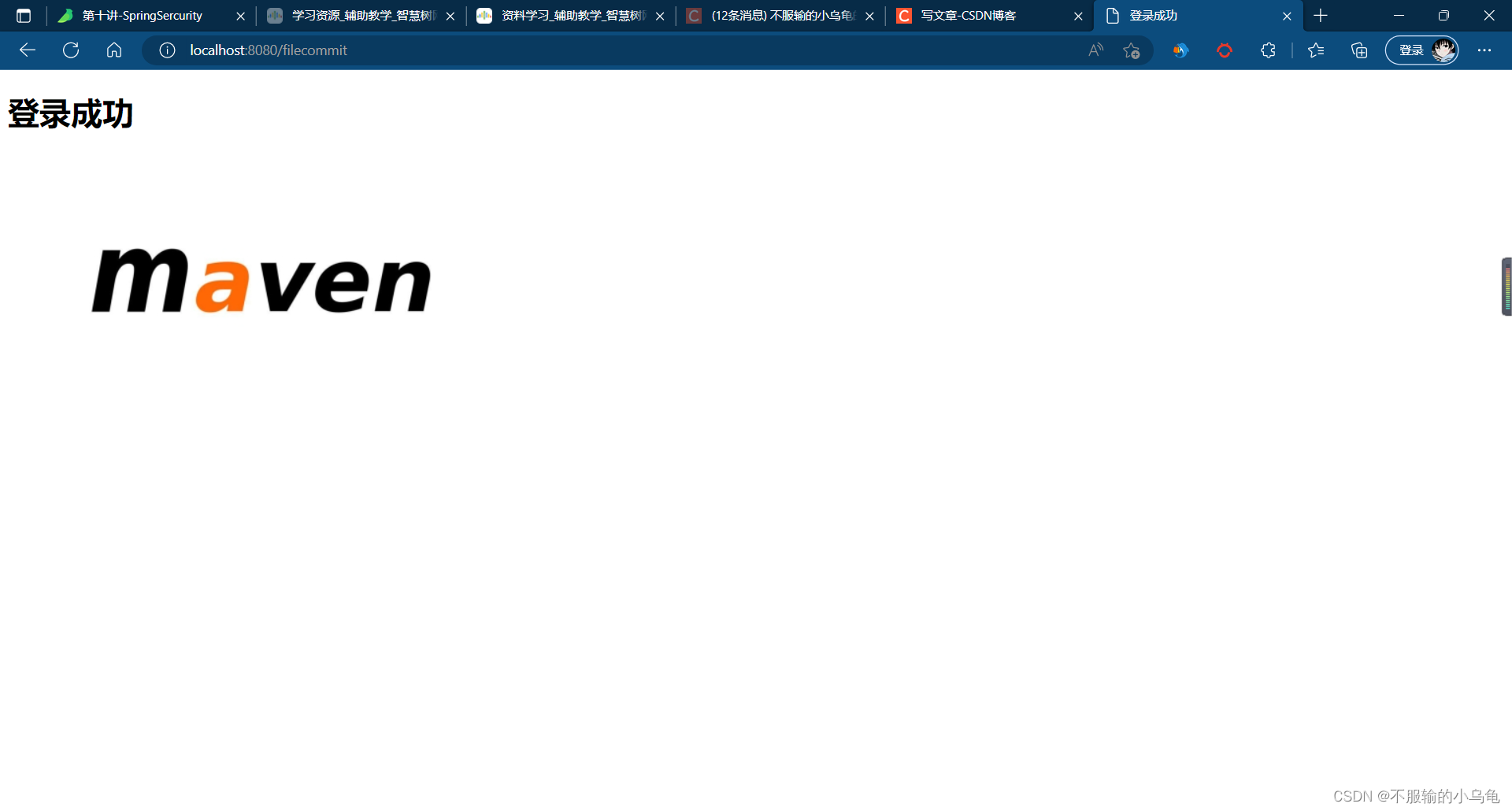
六、请求JSON接口
1、在pojo文件夹下新建News类
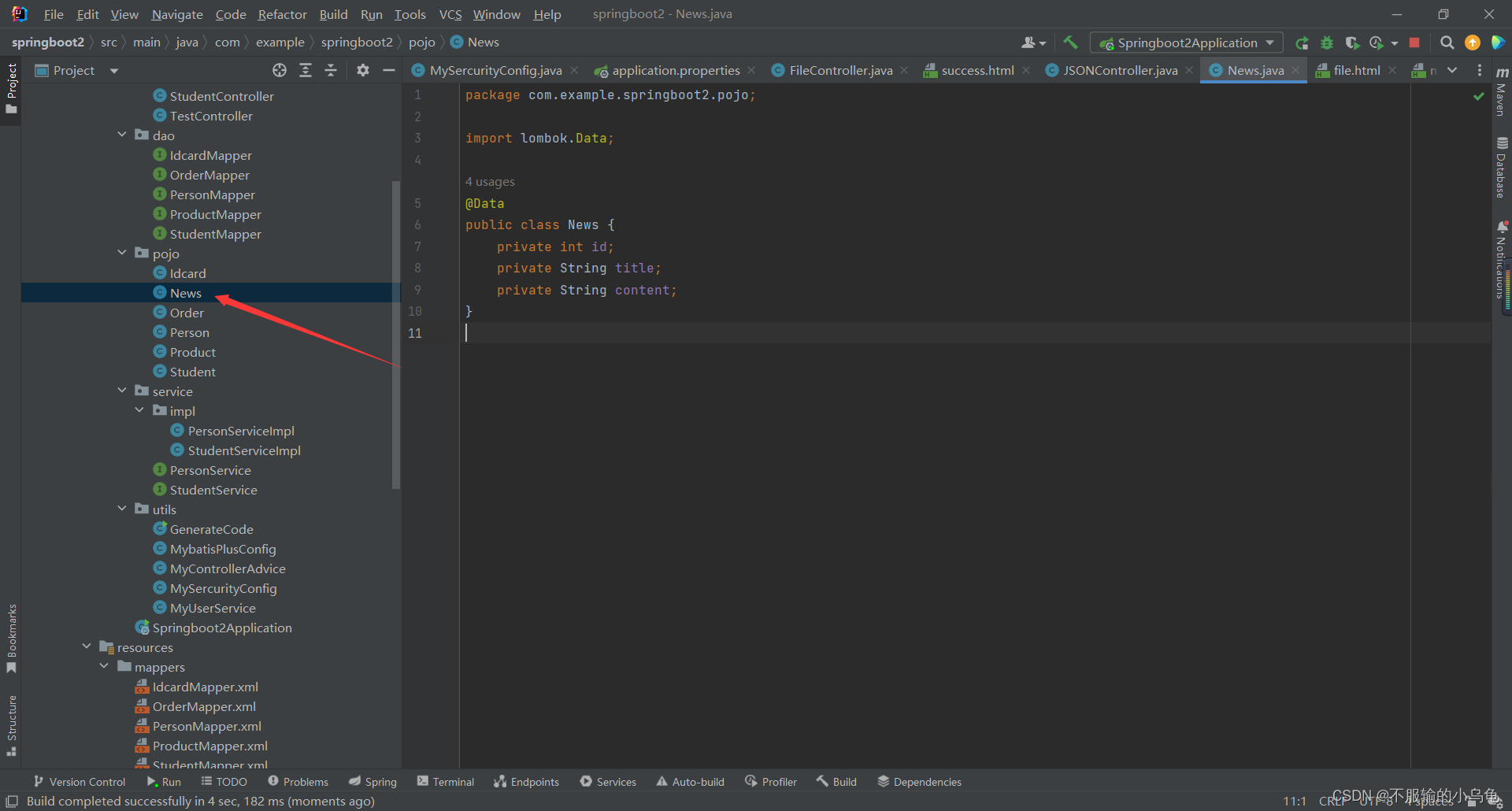
package com.example.springboot2.pojo;
import lombok.Data;
@Data
public class News {
private int id;
private String title;
private String content;
}
2、在controller文件夹下新建JSONController类
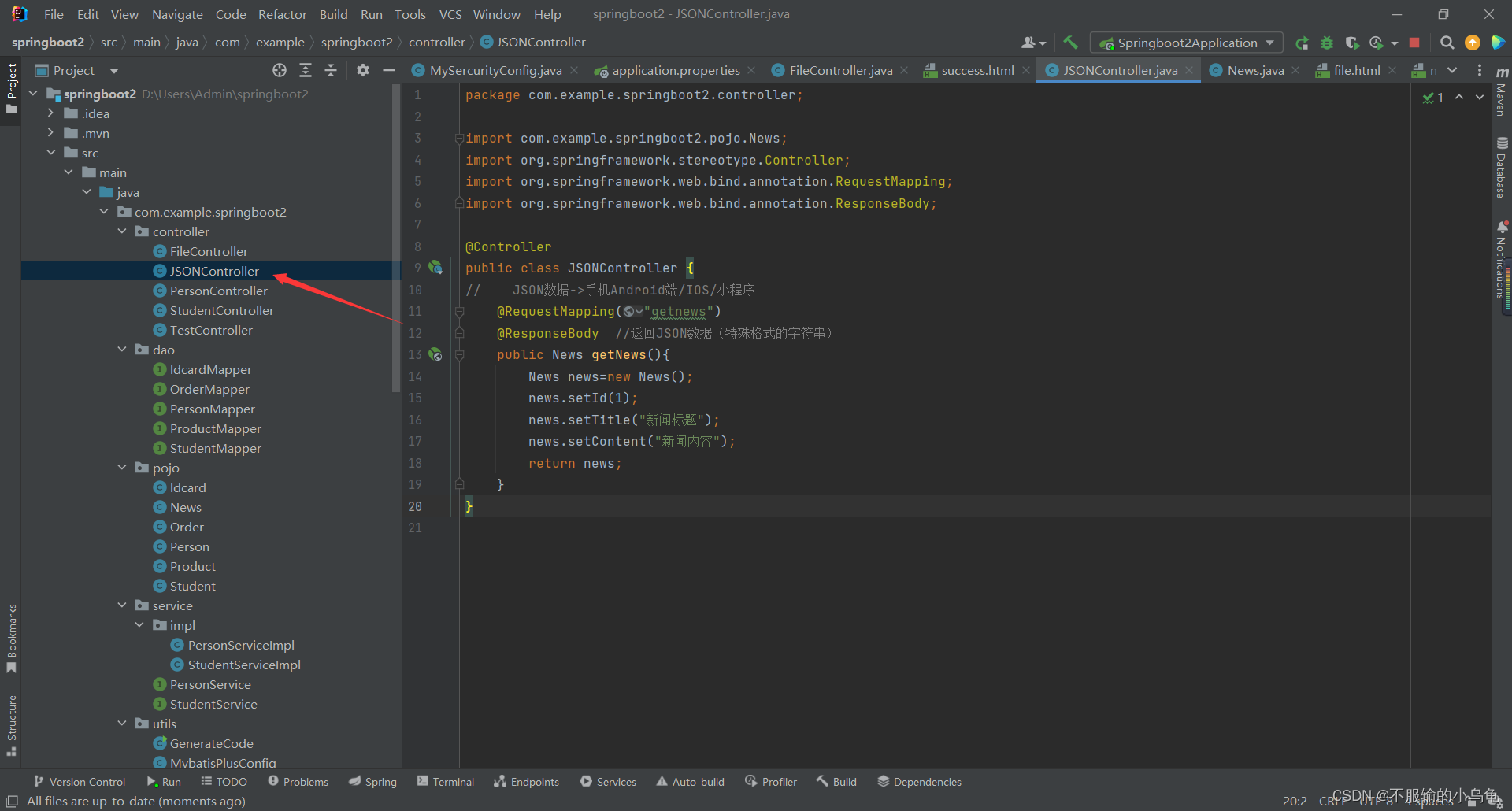
package com.example.springboot2.controller;
import com.example.springboot2.pojo.News;
import org.springframework.stereotype.Controller;
import org.springframework.web.bind.annotation.RequestMapping;
import org.springframework.web.bind.annotation.ResponseBody;
@Controller
public class JSONController {
// JSON数据->手机Android端/IOS/小程序
@RequestMapping("getnews")
@ResponseBody //返回JSON数据(特殊格式的字符串)
public News getNews(){
News news=new News();
news.setId(1);
news.setTitle("新闻标题");
news.setContent("新闻内容");
return news;
}
}
3、修改MySercurityConfig类

// JSON接口配置
http.cors();
http.csrf().disable();
4、在templates文件夹下新建News.html
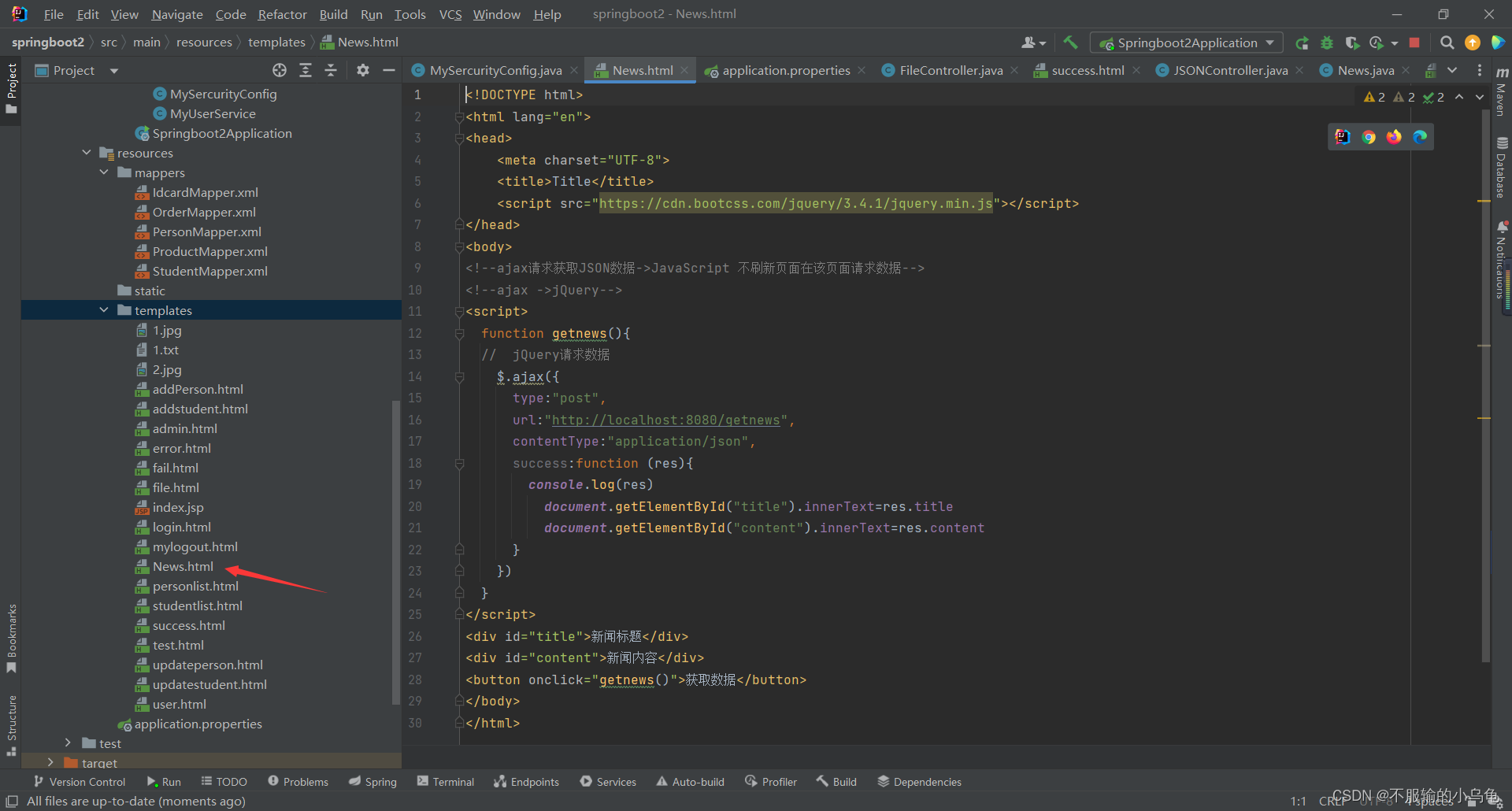
<!DOCTYPE html>
<html lang="en">
<head>
<meta charset="UTF-8">
<title>Title</title>
<script src="https://cdn.bootcss.com/jquery/3.4.1/jquery.min.js"></script>
</head>
<body>
<!--ajax请求获取JSON数据->JavaScript 不刷新页面在该页面请求数据-->
<!--ajax ->jQuery-->
<script>
function getnews(){
// jQuery请求数据
$.ajax({
type:"post",
url:"http://localhost:8080/getnews",
contentType:"application/json",
success:function (res){
console.log(res)
document.getElementById("title").innerText=res.title
document.getElementById("content").innerText=res.content
}
})
}
</script>
<div id="title">新闻标题</div>
<div id="content">新闻内容</div>
<button onclick="getnews()">获取数据</button>
</body>
</html>
5、点击运行,成功获取JSON数据

